挥发性煤焦油沥青(COAL TAR PITCH VOLATILES)化学物质安全资料表
煤沥青应用研究综述

煤沥青应用研究综述高天秀【摘要】煤沥青是煤炭经高温热分解后的副产物煤焦油经进一步蒸馏加工后的产物,煤沥青组成极为复杂,具有稳定的性能,以煤沥青为原料,经过进一步加工后可获得一系列重要的高附加值衍生产品;综述了煤沥青用作煤沥青涂料、筑路沥青、炭素工业浸渍剂和粘结剂以及中间相煤沥青等方面的应用原理和进展。
%Coal tar pitch is a byproduct distillation heavy residue of high temperature carbonization of coal tar after all kinds of light fraction extracted .The composition of coal tar pitch is very complex ,and it has high performance .After further processing ,a series of important high value-added products will be obtained from coal tar pitch .Coal tar pitch as coating materials ,paving materials and impregnating and binder were reviewed in this paper .【期刊名称】《淮南职业技术学院学报》【年(卷),期】2014(000)003【总页数】5页(P10-14)【关键词】煤沥青;中间相沥青;石油沥青;针状焦;碳纤维【作者】高天秀【作者单位】大同煤炭职业技术学院,山西大同 037003【正文语种】中文【中图分类】TQ522.65煤沥青全称为煤焦油沥青(coal tar pitch),是煤焦油经蒸馏加工后的产物。
由于煤焦油加工工艺的不同,生成50%~60%的煤沥青,是目前国内许多煤焦油加工企业生产中的渣料。
317种化学物质IDLH(立即威胁生命和健康浓度)

序号
污染物中文名称
污染物英文名祢
IDLH
浓度'
PPm
Ippm换算mg/m3系数b
(20C)
IDLH浓度’
mg/m3
(20C)
26
苯
benzene
3 000
3. 25
9 800
27
过氧化(二)苯甲酰
benzoyl peroxide
7 000
28
氯化节
benzyl chloride
10
5. 26
8. 72
22000
104
二缩水甘油醯
diglycidyl ether
25
5.41
MO
105
二异丁基甲酮
diisobutyl ketone
2 000
5. 92
12 000
106
二异丙胺
diisopropylamine
1 000
4, 21
4 200
107
二甲基乙酰胺
dimethyl acetamide
acrylonitrile, vinyl cyanide
500
2. 21
1 100
9
艾氏剂
aldrin
100
10
烯丙醇
allyl alcohol
150
2. 42
36。
11
烯丙基氯
allyl chloride
300
3. 18
95()
12
缩水甘油烯丙酰
allyl glycidyl ether
270
4. 75
500
82
十硼烷,十硼氢
decaborane
煤焦油沥青乳化剂及其助剂
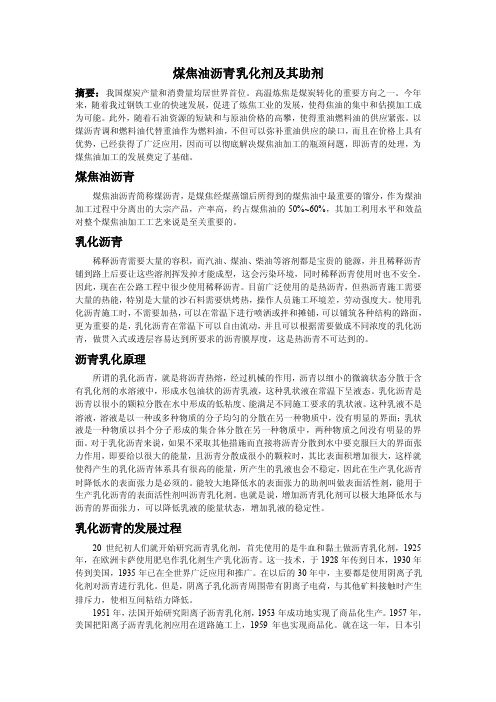
煤焦油沥青乳化剂及其助剂摘要:我国煤炭产量和消费量均居世界首位。
高温炼焦是煤炭转化的重要方向之一。
今年来,随着我过钢铁工业的快速发展,促进了炼焦工业的发展,使得焦油的集中和估摸加工成为可能。
此外,随着石油资源的短缺和与原油价格的高攀,使得重油燃料油的供应紧张。
以煤沥青调和燃料油代替重油作为燃料油,不但可以弥补重油供应的缺口,而且在价格上具有优势,已经获得了广泛应用,因而可以彻底解决煤焦油加工的瓶颈问题,即沥青的处理,为煤焦油加工的发展奠定了基础。
煤焦油沥青煤焦油沥青简称煤沥青,是煤焦经煤蒸馏后所得到的煤焦油中最重要的馏分,作为煤油加工过程中分离出的大宗产品,产率高,约占煤焦油的50%~60%,其加工利用水平和效益对整个煤焦油加工工艺来说是至关重要的。
乳化沥青稀释沥青需要大量的容积,而汽油、煤油、柴油等溶剂都是宝贵的能源,并且稀释沥青铺到路上后要让这些溶剂挥发掉才能成型,这会污染环境,同时稀释沥青使用时也不安全。
因此,现在在公路工程中很少使用稀释沥青。
目前广泛使用的是热沥青,但热沥青施工需要大量的热能,特别是大量的沙石料需要烘烤热,操作人员施工环境差,劳动强度大。
使用乳化沥青施工时,不需要加热,可以在常温下进行喷洒或拌和摊铺,可以铺筑各种结构的路面,更为重要的是,乳化沥青在常温下可以自由流动,并且可以根据需要做成不同浓度的乳化沥青,做贯入式或透层容易达到所要求的沥青膜厚度,这是热沥青不可达到的。
沥青乳化原理所谓的乳化沥青,就是将沥青热熔,经过机械的作用,沥青以细小的微滴状态分散于含有乳化剂的水溶液中,形成水包油状的沥青乳液,这种乳状液在常温下呈液态。
乳化沥青是沥青以很小的颗粒分散在水中形成的低粘度、能满足不同施工要求的乳状液。
这种乳液不是溶液,溶液是以一种或多种物质的分子均匀的分散在另一种物质中,没有明显的界面;乳状液是一种物质以抖个分子形成的集合体分散在另一种物质中,两种物质之间没有明显的界面。
煤焦油沥青GC-MS分析

煤焦油沥青GC-MS分析【摘要】煤焦油沥青是一种成分极其复杂的混合物。
煤焦油沥青用甲苯萃取后,借助于气相色谱质谱联用仪(GC-MS)可以测定其中的芳烃和杂环化合物,为提高煤焦油沥青附加值利用提供实验依据。
【关键词】煤焦油沥青(CTP);甲苯;萃取;气相色谱质谱联用仪;芳烃1.引言气相色谱法(Gas Chromatography)是一种广泛应用非常广泛的分离手段,它是以惰性气体作为流动相的柱色谱法,其分离原理是基于样品中的组分在两相间分配上的差异。
气相色谱法虽然可以将复杂混合物中的各个组分分离开,但其定性能力较差,通常只是利用组分的保留特性来定性,这在欲定性的组分完全未知或无法获得组分的标准样品时,对组分定性分析就十分困难了。
随着质谱、红外光谱及核磁共振等定性分析手段的发展,目前主要采用在线的联用技术,即将色谱法与其它定性或结构分析手段直接联机,来解决色谱定性困难的问题。
气相色谱-质谱联用(GC-MS)是最早实现商品化的色谱联用仪器,实验一次进样体积仅为0.2µL,可以节省不少原料,因此,小型台式GC-MS使用较为普遍。
2. GC/MS的使用原理气相色谱(Gas Chromatography,GC)具有极强的分离能力;质谱(Mass spectrometry,MS)对未知化合物具有独特的鉴定能力,且灵敏度极高,因此GC-MS是分离和检测复杂化合物的最有力工具之一。
质量分析器是质谱仪的核心,它将离子源产生的离子按质荷比(m/z)的不同,在空间位置、时间的先后或轨道的稳定与否进行分离,以得到按质荷比大小顺序排列的质谱图。
标准质谱图是在标准电离条件——70eV电子束轰击已知纯有机化合物得到的质谱图。
在气相色谱-质谱联用仪中,进行组分定性的常用方法是标准谱库检索。
即利用计算机将待分析组分(纯化合物)的质谱图与计算机内保存的已知化合物的标准质谱图按一定程序进行比较,将匹配度(相似度)最高的若干个化合物的名称、分子量、分子式、识别代号及匹配率等数据列出供用户参考。
我国和美国OELs(职业接触限值)对照表

1
3
80.11 A4
101
氢氧化钙Calcium hydroxide
5mg/m3
74.1
102
氧化钙Calcium oxide
2mg/m3
2
5
56.08
103
硅酸钙(合成) Calcium silicate
10mg/m3
A4
104
硫酸钙Calcium sulfate
10mg/m3
136.14
0.1ppm
174.92
76
溴仿Bromoform
0.5ppm
252.80 A3
77
1,3-丁二烯1,3-Butadiene
2ppm
5
12.5
54.09 A2
78
丁烷Butane
800ppm
58.12
79
正丁醇n-Butanol
C 50ppm
100
200
74.12
80
仲丁醇sec-Butanol
100ppm
可溶性盐,以铝计
2mg/m3
烷基铝,以铝计
2mg/m3
铝、铝合金总尘
3
4
25
氧化铝Aluminum oxide
10mg/m3
A4
总尘
4
6
26
4-氨基联苯4-Aminodiphenyl
169.23 A1
27
2-氨基吡啶2-Aminopyridine
0.5ppm
2
5
91.11
28
3-氨基-1,2,4-三唑3-Amino-1,2,4-triazole
16
活性炭粉尘(总尘)
工作场所化学有害因素职业接触限值
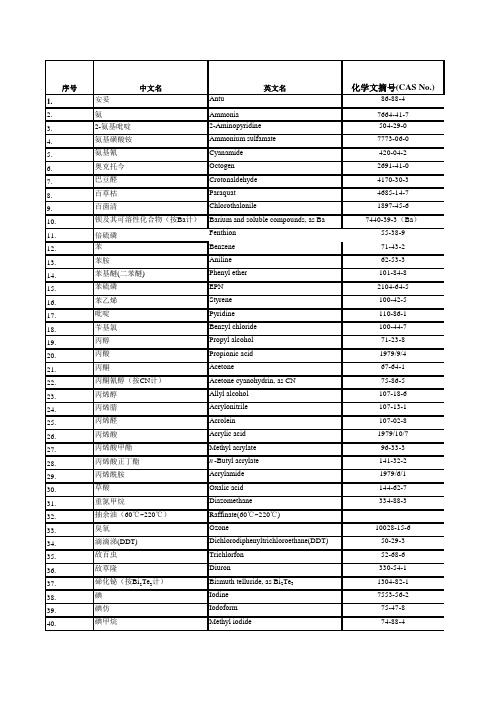
1. 安妥Antu86-88-42.氨Ammonia7664-41-73. 2-氨基吡啶2-Aminopyridine504-29-04. 氨基磺酸铵Ammonium sulfamate 7773-06-05. 氨基氰Cyanamide 420-04-26. 奥克托今Octogen 2691-41-07. 巴豆醛Crotonaldehyde 4170-30-38. 百草枯Paraquat 4685-14-79. 百菌清Chlorothalonile1897-45-610. 钡及其可溶性化合物(按Ba 计)Barium and soluble compounds, as Ba 7440-39-3(Ba )11. 倍硫磷Fenthion 55-38-912.苯Benzene 71-43-213. 苯胺Aniline 62-53-314. 苯基醚(二苯醚)Phenyl ether 101-84-815. 苯硫磷EPN 2104-64-516. 苯乙烯Styrene 100-42-517. 吡啶Pyridine 110-86-118. 苄基氯Benzyl chloride 100-44-719. 丙醇Propyl alcohol 71-23-820. 丙酸Propionic acid 1979-9-421. 丙酮Acetone67-64-122. 丙酮氰醇(按CN 计)Acetone cyanohydrin, as CN 75-86-523. 丙烯醇Allyl alcohol 107-18-624. 丙烯腈Acrylonitrile 107-13-125. 丙烯醛Acrolein 107-02-826. 丙烯酸Acrylic acid 1979-10-727. 丙烯酸甲酯Methyl acrylate 96-33-328. 丙烯酸正丁酯n -Butyl acrylate 141-32-229. 丙烯酰胺Acrylamide 1979-6-130. 草酸Oxalic acid 144-62-731. 重氮甲烷Diazomethane 334-88-332. 抽余油(60℃~220℃)Raffinate(60℃~220℃)33. 臭氧Ozone10028-15-634. 滴滴涕(DDT)Dichlorodiphenyltrichloroethane(DDT)50-29-335. 敌百虫Trichlorfon 52-68-636. 敌草隆Diuron330-54-137. 碲化铋(按Bi 2Te 3计)Bismuth telluride, as Bi 2Te 31304-82-138. 碘Iodine 7553-56-239. 碘仿Iodoform 75-47-840.碘甲烷Methyl iodide74-88-4中文名英文名化学文摘号(CAS No.)序号41. 叠氮酸蒸气Hydrazoic acid vapor 7782-79-842. 叠氮化钠Sodium azide 26628-22-843. 丁醇Butyl alcohol 71-36-344. 1,3-丁二烯1,3-Butadiene 106-99-045. 丁醛Butylaldehyde 123-72-846. 丁酮Methyl ethyl ketone 78-93-347. 丁烯Butylene 25167-67-348. 毒死蜱Chlorpyrifos 2921-88-249. 对苯二甲酸Terephthalic acid 100-21-050. 对二氯苯p -Dichlorobenzene 106-46-751. 对茴香胺p -Anisidine 104-94-952. 对硫磷Parathion56-38-253. 对特丁基甲苯p -Tert-butyltoluene 98-51-154.对硝基苯胺p –Nitroaniline 100-01-655. 对硝基氯苯p -Nitrochlorobenzene 100-00-556. 多次甲基多苯基多异氰酸酯Polymetyhlenepolyphenylisocyanate(PMPPI)57029-46-657. 二苯胺Diphenylamine122-39-458. 二苯基甲烷二异氰酸酯Diphenylmethane diisocyanate 101-68-859. 二丙二醇甲醚Dipropylene glycol methyl ether 34590-94-860. 2-N-二丁氨基乙醇2-N-Dibutylaminoethanol 102-81-861. 二噁烷1,1,4-Dioxane 123-91-162. 二氟氯甲烷Chlorodifluoromethane 75-45-663.二甲胺Dimethylamine 124-40-31330-20-7;95-47-6;108-38-365. 二甲基苯胺Dimethylanilne121-69-766. 1,3-二甲基丁基醋酸酯(乙酸仲己酯)1,3-Dimethylbutylacetate(sec-hexylacetate)108-84-967. 二甲基二氯硅烷Dimethyl dichlorosilane 75-78-568. 二甲基甲酰胺Dimethylformamide(DMF)1968-12-269. 3,3-二甲基联苯胺3,3-Dimethylbenzidine 119-93-770. N,N-二甲基乙酰胺Dimethyl acetamide 127-19-571. 二聚环戊二烯Dicyclopentadiene 77-73-672. 二硫化碳Carbon disulfide75-15-073. 1,1-二氯-1-硝基乙烷1,1-Dichloro-1-nitroethane 594-72-974. 1,3-二氯丙醇1,3-Dichloropropanol 96-23-175. 1,2-二氯丙烷1,2-Dichloropropane 78-87-576. 1,3-二氯丙烯1,3-Dichloropropene 542-75-677. 二氯二氟甲烷Dichlorodifluoromethane 75-71-878. 二氯甲烷Dichloromethane 1975-9-279. 二氯乙炔Dichloroacetylene 7572-29-480.1,2-二氯乙烷1,2-Dichloroethane107-06-264. 二甲苯(全部异构体)Xylene(all isomers)81. 1,2-二氯乙烯1,2-Dichloroethylene 540-59-082.二缩水甘油醚Diglycidyl ether2238-7-583. 二硝基苯(全部异构体)Dinitrobenzene(all isomers)528-29-0; 99-65-0; 100-25-484. 二硝基甲苯Dinitrotoluene25321-14-685. 4,6-二硝基邻苯甲酚4,6-Dinitro-o-cresol 534-52-186. 二硝基氯苯Dinitrochlorobenzene 25567-67-387. 二氧化氮Nitrogen dioxide 10102-44-088. 二氧化硫Sulfur dioxide 7446-9-589. 二氧化氯Chlorine dioxide 10049-04-490. 二氧化碳Carbon dioxide 124-38-991. 二氧化锡(按Sn 计)Tin dioxide,as Sn 1332-29-292. 2-二乙氨基乙醇2-Diethylaminoethanol 100-37-893. 二亚乙基三胺Diethylene triamine 111-40-094. 二乙基甲酮Diethyl ketone 96-22-095. 二乙烯基苯Divinyl benzene 1321-74-096. 二异丁基甲酮Diisobutyl ketone 108-83-8Toluene-2,4 -diisocyanate (TDI )98.二月桂酸二丁基锡Dibutyltin dilaurate77-58-7钒及其化合物(按V 计)Vanadium and compounds,as V 7440-62-6(V )五氧化二钒烟尘Vanadium pentoxide fume 、dust 钒铁合金尘Ferrovanadium alloy dust 100. 酚Phenol 108-95-2101. 呋喃Furan110-00-9102. 氟化氢(按F 计)Hydrogen fluoride, as F 7664-39-3103. 氟化物(不含氟化氢)(按F 计)Fluorides(except HF) , as F 104. 锆及其化合物(按Zr 计)Zirconium and compounds, as Zr 7440-67-7(Zr )105. 镉及其化合物(按Cd 计)Cadmium and compounds, as Cd7440-43-9(Cd )106. 汞-金属汞(蒸气)Mercury metal (vapor )7439-97-6107. 汞-有机汞化合物(按Hg 计)Mercury organic compounds, as Hg 108. 钴及其氧化物(按Co 计)Cobalt and oxides, as Co 7440-48-4(Co )109. 光气Phosgene 75-44-5110. 癸硼烷Decaborane 17702-41-9111. 过氧化苯甲酰Benzoyl peroxide 94-36-0112. 过氧化氢Hydrogen peroxide 7722-84-1113. 环己胺Cyclohexylamine 108-91-8114. 环己醇Cyclohexanol 108-93-0115. 环己酮Cyclohexanone 108-94-1116. 环己烷Cyclohexane 110-82-7117. 环氧丙烷Propylene Oxide 75-56-9118.环氧氯丙烷Epichlorohydrin106-89-899. 97. 二异氰酸甲苯酯(TDI )584-84-9119. 环氧乙烷Ethylene oxide 75-21-8120. 黄磷Yellow phosphorus 7723-14-0121. 己二醇Hexylene glycol107-41-5122. 1,6-己二异氰酸酯Hexamethylene diisocyanate 822-06-0123. 己内酰胺Caprolactam 105-60-2124. 2-己酮2-Hexanone 591-78-6125. 甲拌磷Thimet 298-02-2126. 甲苯Toluene 108-88-3127. N-甲苯胺N -Methyl aniline 100-61-8128.甲醇Methanol 67-56-11319-77-3;95-48-7;108-39-4;106-44-5130. 甲基丙烯腈Methylacrylonitrile 126-98-7131. 甲基丙烯酸Methacrylic acid 79-41-4132. 甲基丙烯酸甲酯Methyl methacrylate 80-62-6133. 甲基丙烯酸缩水甘油酯Glycidyl methacrylate 106-91-2134. 甲基肼Methyl hydrazine 60-34-4135. 甲基内吸磷Methyl demeton 8022-00-2136. 18-甲基炔诺酮(炔诺孕酮)18-Methyl norgestrel 6533-00-2137. 甲硫醇Methyl mercaptan 74-93-1138. 甲醛Formaldehyde 50-00-0139. 甲酸Formic acid 64 -18-6140. 甲氧基乙醇2-Methoxyethanol 109-86-4141. 甲氧氯Methoxychlor 72-43-5142. 间苯二酚Resorcinol108-46-3143. 焦炉逸散物(按苯溶物计)Coke oven emissions,as benzene soluble matter 144. 肼Hydrazine 302-01-2145. 久效磷Monocrotophos 6923-22-4146. 糠醇Furfuryl alcohol 98-00-0147. 糠醛Furfural 1998-1-1148. 考的松Cortisone 1953-6-5149. 苦味酸Picric acid 88-89-1150. 乐果Rogor 60-51-5152. 邻苯二甲酸二丁酯Dibutyl phthalate 84-74-2153. 邻苯二甲酸酐Phthalic anhydride 85-44-9154. 邻二氯苯o -Dichlorobenzene 95-50-1155. 邻茴香胺o -Anisidine 90-04-0156. 邻氯苯乙烯o -Chlorostyrene2038-87-47157.邻氯苄叉丙二腈o -Chlorobenzylidene malononitrile2698-41-192-52-4129. 甲酚(全部异构体)Cresol(all isomers)151. 联苯Biphenyl158.邻仲丁基苯酚o-sec-Butylphenol89-72-5 159.磷胺Phosphamidon13171-21-6 160.磷化氢Phosphine7803-51-2 161.磷酸Phosphoric acid7664-38-2 162.磷酸二丁基苯酯Dibutyl phenyl phosphate2528-36-1 163.硫化氢Hydrogen sulfide7783-6-4 164.硫酸钡(按Ba计)Barium sulfate, as Ba7727-43-7 165.硫酸二甲酯Dimethyl sulfate77-78-1 166.硫酸及三氧化硫Sulfuric acid and sulfur trioxide7664-93-9 167.硫酰氟Sulfuryl fluoride2699-79-8 168.六氟丙酮Hexafluoroacetone684-16-2 169.六氟丙烯Hexafluoropropylene116-15-4 170.六氟化硫Sulfur hexafluoride2551-62-4 171.六六六Hexachlorocyclohexane608-73-1 172.γ-六六六γ-Hexachlorocyclohexane58-89-9 173.六氯丁二烯Hexachlorobutadine87-68-3 174.六氯环戊二烯Hexachlorocyclopentadiene77-47-4 175.六氯萘Hexachloronaphthalene1335-87-1 176.六氯乙烷Hexachloroethane67-72-1 177.氯Chlorine7782-50-5 178.氯苯Chlorobenzene108-90-7 179.氯丙酮Chloroacetone78-95-5 180.氯丙烯Allyl chloride107-05-1 181.β-氯丁二烯Chloroprene126-99-8 182.氯化铵烟Ammonium chloride fume12125-02-9 183.氯化苦Chloropicrin1976-6-2 184.氯化氢及盐酸Hydrogen chloride and chlorhydric acid7647-01-0 185.氯化氰Cyanogen chloride506-77-4 186.氯化锌烟Zinc chloride fume7646-85-7 187.氯甲甲醚Chloromethyl methyl ether107-30-2 188.氯甲烷Methyl chloride74-87-3 189.氯联苯(54%氯)Chlorodiphenyl (54%Cl)11097-69-1 190.氯萘Chloronaphthalene90-13-1 191.氯乙醇Ethylene chlorohydrin107-07-3 192.氯乙醛Chloroacetaldehyde107-20-0 193.氯乙酸Chloroacetic acid1979-11-8 194.氯乙烯Vinyl chloride1975-1-4 195.a-氯乙酰苯a-Chloroacetophenone532-27-4 196.氯乙酰氯Chloroacetyl chloride1979-4-9 197.马拉硫磷Malathion121-75-5 198.马来酸酐Maleic anhydride108-31-6 199.吗啉Morpholine110-91-8200. 煤焦油沥青挥发物(按苯溶物计)Coal tar pitch volatiles,as Benzene soluble matters65996-93-2201.锰及其无机化合物(按MnO 2计)Manganese and inorganic compounds,as MnO 27439-96-5(Mn )钼及其化合物(按Mo 计)Molybdeum and compounds, as Mo 7439-98-7(Mo )钼,不溶性化合物Molybdeum and insoluble compounds 可溶性化合物soluble compounds 203. 内吸磷Demeton 8065-48-3204. 萘Naphthalene 91-20-3205. 2-萘酚2-Naphthol 2814-77-9206. 萘烷Decalin 91-17-8207.尿素Urea57-13-6镍及其无机化合物(按Ni 计)Nickel and inorganic compounds, as Ni 金属镍与难溶性镍化合物Nickel metal and insoluble compounds 7440-02-0(Ni )可溶性镍化合物Soluble nickel compounds 209. 铍及其化合物(按Be 计)Beryllium and compounds, as Be 7440-41-7(Be )210.偏二甲基肼Unsymmetric dimethylhydrazine 57-14-7铅及其无机化合物(按Pb 计)Lead and inorganic Compounds, as Pb7439-92-1(Pb )铅尘Lead dust 铅烟Lead fume 212. 氢化锂Lithium hydride 7580-67-8213. 氢醌Hydroquinone 123-31-9214. 氢氧化钾Potassium hydroxide 1310-58-3215. 氢氧化钠Sodium hydroxide 1310-73-2216. 氢氧化铯Cesium hydroxide 21351-79-1217. 氰氨化钙Calcium cyanamide 156-62-7218. 氰化氢(按CN 计)Hydrogen cyanide,as CN 74-90-8219. 氰化物(按CN 计)Cyanides, as CN 460-19-5 (CN)220. 氰戊菊酯Fenvalerate 51630-58-1221. 全氟异丁烯Perfluoroisobutylene 382-21-8222. 壬烷Nonane 111-84-2223. 溶剂汽油Solvent gasolines 224. 乳酸正丁酯n-Butyl lactate 138-22-7225. 三次甲基三硝基胺(黑索今)Cyclonite (RDX)121-82-4226. 三氟化氯Chlorine trifluoride 7790-91-2227. 三氟化硼Boron trifluoride7637-7-2228. 三氟甲基次氟酸酯Trifluoromethyl hypofluorite 229. 三甲苯磷酸酯Tricresyl phosphate 1330-78-5230. 1,2,3-三氯丙烷1,2,3-Trichloropropane 96-18-4231. 三氯化磷Phosphorus trichloride 7719-12-2232. 三氯甲烷Trichloromethane 67-66-3233. 三氯硫磷Phosphorous thiochloride 3982-91-0234.三氯氢硅Trichlorosilane10025-28-2202. 208. 211.235.三氯氧磷Phosphorus oxychloride10025-87-3 236.三氯乙醛Trichloroacetaldehyde75-87-6 237.1,1,1-三氯乙烷1,1,1-trichloroethane71-55-6 238.三氯乙烯Trichloroethylene1979-1-6 239.三硝基甲苯Trinitrotoluene118-96-7240.三氧化铬、铬酸盐、重铬酸盐(按Cr计)Chromium trioxide、chromate、dichromate, as Cr7440-47-3(Cr)241.三乙基氯化锡Triethyltin chloride994-31-0 242.杀螟松Sumithion122-14-5 243.砷化氢(胂)Arsine7784-42-1 244.砷及其无机化合物(按As计)Arsenic and inorganic compounds, as As7440-38-2(As)245.升汞(氯化汞)Mercuric chloride7487-94-7 246.石腊烟Paraffin wax fume8002-74-2247.石油沥青烟(按苯溶物计)Asphalt(petroleum)fume,as benzenesoluble matter8052-42-4248.双(巯基乙酸)二辛基锡Bis(marcaptoacetate) dioctyltin26401-97-8249.双丙酮醇Diacetone alcohol123-42-2250.双硫醒Disulfiram97-77-8251.双氯甲醚Bis(chloromethyl) ether542-88-1252.四氯化碳Carbon tetrachloride56-23-5253.四氯乙烯Tetrachloroethylene127-18-4254.四氢呋喃Tetrahydrofuran109-99-9255.四氢化锗Germanium tetrahydride7782-65-2256.四溴化碳Carbon tetrabromide558-13-4257.四乙基铅(按Pb计)Tetraethyl lead, as Pb78-00-2258.松节油Turpentine8006-64-2259.铊及其可溶性化合物(按Tl计)Thallium and soluble compounds, as Tl7440-28-0(Tl)260.钽及其氧化物(按Ta计)Tantalum and oxide,as Ta7440-25-7(Ta)261.碳酸钠(纯碱)Sodium carbonate3313-92-6262.羰基氟Carbonyl fluoride353-50-4263.羰基镍(按Ni计)Nickel carbonyl, as Ni13463-39-3264.锑及其化合物(按Sb计)Antimony and compounds ,as Sb7440-36-0(Sb)铜(按Cu计)Copper,as Cu7440-50-8铜尘Copper dust铜烟Copper fume266.钨及其不溶性化合物(按W计)Tungsten and insoluble compounds, as W7440-33-7(W)267.五氟氯乙烷Chloropentafluoroethane76-15-3268.五硫化二磷Phosphorus pentasulfide1314 -80-3269.五氯酚及其钠盐Pentachlorophenol and sodium salts87-86-5270.五羰基铁(按Fe计)Iron pentacarbonyl, as Fe13463-40-6271.五氧化二磷Phosphorus pentoxide1314-56-3272.戊醇Amyl alcohol71-41-0273.戊烷(全部异构体)Pentane (all isomers)78-78-4;109-66-0;463-82-1 274.硒化氢(按Se计)Hydrogen selenide, as Se7783-7-5265.275.硒及其化合物(按Se计)(不包括六氟化硒、硒化氢)Selenium and compounds,as Se(excepthexafluoride, hydrogen selenide)7782-49-2(Se)276.纤维素Cellulose9004-34-6 277.硝化甘油Nitroglycerine55-63-0278.硝基苯Nitrobenzene98-95-3279.1-硝基丙烷1-Nitropropane108-03-2280.2-硝基丙烷2-Nitropropane79-46-9281.硝基甲苯(全部异构体)Nitrotoluene (all isomers)88-72-2; 99-08-1; 99-99-0 282.硝基甲烷Nitromethane75-52-5283.硝基乙烷Nitroethane79-24-3284.辛烷Octane111-65-9285.溴Bromine7726-95-6 286.溴化氢Hydrogen bromide10035-10-6 287.溴甲烷Methyl bromide74-83-9288.溴氰菊酯Deltamethrin52918-63-5 289.氧化钙Calcium oxide1305-78-8 290.氧化镁烟Magnesium oxide fume1309-48-4 291.氧化锌Zinc oxide1314-13-2 292.氧乐果Omethoate1113-02-6 293.液化石油气Liquified petroleum gas(L.P.G.)68476-85-7 294.一甲胺Monomethylamine74-89-5295.一氧化氮Nitric oxide(Nitrogen monoxide)10102-43-9一氧化碳Carbon monoxide630-08-0非高原not in high altitude area高原In high altitude area海拔2000~3000m2000~3000m海拔>3000m>3000m297.乙胺Ethylamine1975-4-7298.乙苯Ethyl benzene100-41-4299.乙醇胺Ethanolamine141-43-5300.乙二胺Ethylenediamine107-15-3301.乙二醇Ethylene glycol107-21-1302.乙二醇二硝酸酯Ethylene glycol dinitrate628-96-6303.乙酐Acetic anhydride108-24-7304.N-乙基吗啉N-Ethylmorpholine100-74-3305.乙基戊基甲酮Ethyl amyl ketone541-85-5306.乙腈Acetonitrile1975-5-8307.乙硫醇Ethyl mercaptan1975-8-1308.乙醚Ethyl ether60-29-7309.乙硼烷Diborane19287-45-7 310.乙醛Acetaldehyde75-07-0311.乙酸Acetic acid64-19-7312.2-甲氧基乙基乙酸酯2-Methoxyethyl acetate110-49-6296.313. 乙酸丙酯Propyl acetate 109-60-4314. 乙酸丁酯Butyl acetate 123-86-4315. 乙酸甲酯Methyl acetate79-20-9316. 乙酸戊酯(全部异构体)Amyl acetate (all isomers)628-63-7317. 乙酸乙烯酯Vinyl acetate 108-05-4318. 乙酸乙酯Ethyl acetate 141-78-6319. 乙烯酮Ketene 463-51-4320. 乙酰甲胺磷Acephate30560-19-1321. 乙酰水杨酸(阿司匹林)Acetylsalicylic acid(aspirin)50-78-2322. 2-乙氧基乙醇2-Ethoxyethanol 110-80-5323. 2-乙氧基乙基乙酸酯2-Ethoxyethyl acetate 111-15-9324. 钇及其化合物(按Y 计)Yttrium and compounds (as Y)7440-65-5325. 异丙胺Isopropylamine 75-31-0326. 异丙醇Isopropyl alcohol (IPA)67-63-0327. N-异丙基苯胺N-Isopropylaniline 768-52-5328. 异稻瘟净Kitazin o-p 26087-47-8329. 异佛尔酮Isophorone78-59-1330. 异佛尔酮二异氰酸酯Isophorone diisocyanate (IPDI)4098-71-9331. 异氰酸甲酯Methyl isocyanate 624-83-9332. 异亚丙基丙酮Mesityl oxide141-79-7333. 铟及其化合物(按In 计)Indium and compounds, as In 7440-74-6(In )334. 茚Indene 95-13-6335. 正丁胺n -butylamine 109-73-9336. 正丁基硫醇n -butyl mercaptan 109-79-5337. 正丁基缩水甘油醚n -butyl glycidyl ether 2426-8-6338. 正庚烷n -Heptane 142-82-5339.正己烷n -Hexane110-54-34.2 工作场所空气中粉尘容许浓度工作场所空气中粉尘容许浓度见表2。
煤沥青 Coal Pitch

煤沥青 Coal Pitch
各种天然有机物(如煤、木材、泥炭或页岩等)在隔绝空气的情况下,经焦化、干馏得到的粘性液体,通称“焦油”。焦油再经进一步加工而得到粘稠液体以致半固体的产品称为“焦油沥青”。通常加工焦油沥青的原料为煤,故称“煤焦油沥青”,简称“煤沥青”。
各种煤沥青按其稠度可分为:软煤沥青和硬煤沥青两类。软煤沥青是煤焦油在进一步加工时,仅馏出其中部分轻油和中油而得到的粘稠液体或半固体产品。硬煤沥青是煤焦油在分馏时馏出轻油、中油、重油以致蒽油等大部分油品而得到的脆硬的固体产品。硬煤沥青不能直接用于筑路,硬煤沥青可用蒽油回配为软煤沥青。
理化性质:室温下为黑色脆性块状物, 有光泽;臭味, 熔融时易燃烧, 并有毒。属二级易燃固体。本产品符合GB/T2290-94中温沥青标准。
用途:用于制造涂料、电极、沥青焦、油毛毡等, 亦可作燃料及沥青炭黑的原料。
包装:纺织袋装、散装都可。
煤沥青 Coal Pitch
理化性质:室温下为黑色脆性块状物, 有光泽;臭味, 熔融时易燃烧, 并有毒。属二级易燃固体。本产品符合GB/T2290-94中温沥青标准。
用途:用于制造涂料、电极、沥青焦、油毛毡等, 亦可作燃料及沥青是由煤干馏得到的煤焦油再经蒸馏加工制成的沥青。煤沥青与石油沥青相比,在技术性质上有下列差异:温度稳定性较低,与矿质集料的粘附性较好,气候稳定性较差,以及含对人体有害成分较多、臭味较重。
煤焦油的理化性质及简介 (1)
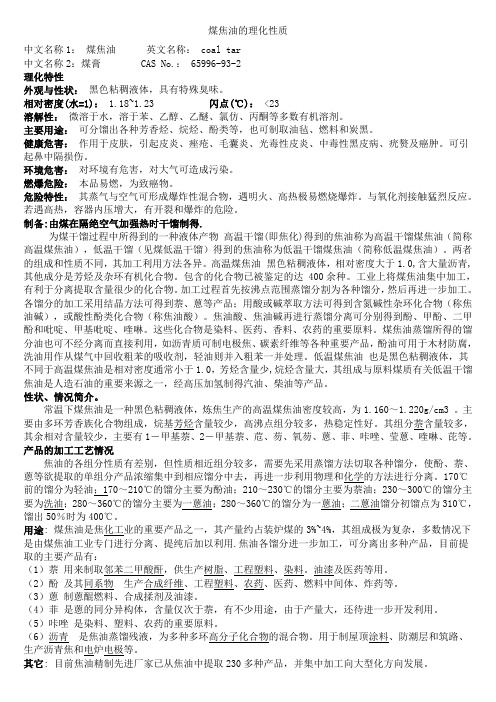
煤焦油的理化性质中文名称1:煤焦油英文名称: coal tar中文名称2:煤膏 CAS No.: 65996-93-2理化特性外观与性状:黑色粘稠液体,具有特殊臭味。
相对密度(水=1): 1.18~1.23 闪点(℃): <23溶解性:微溶于水,溶于苯、乙醇、乙醚、氯仿、丙酮等多数有机溶剂。
主要用途:可分馏出各种芳香烃、烷烃、酚类等,也可制取油毡、燃料和炭黑。
健康危害:作用于皮肤,引起皮炎、痤疮、毛囊炎、光毒性皮炎、中毒性黑皮病、疣赘及癌肿。
可引起鼻中隔损伤。
环境危害:对环境有危害,对大气可造成污染。
燃爆危险:本品易燃,为致癌物。
危险特性:其蒸气与空气可形成爆炸性混合物,遇明火、高热极易燃烧爆炸。
与氧化剂接触猛烈反应。
若遇高热,容器内压增大,有开裂和爆炸的危险。
制备:由煤在隔绝空气加强热时干馏制得.为煤干馏过程中所得到的一种液体产物高温干馏(即焦化)得到的焦油称为高温干馏煤焦油(简称高温煤焦油),低温干馏(见煤低温干馏)得到的焦油称为低温干馏煤焦油(简称低温煤焦油)。
两者的组成和性质不同,其加工利用方法各异。
高温煤焦油黑色粘稠液体,相对密度大于1.0,含大量沥青,其他成分是芳烃及杂环有机化合物。
包含的化合物已被鉴定的达 400余种。
工业上将煤焦油集中加工,有利于分离提取含量很少的化合物。
加工过程首先按沸点范围蒸馏分割为各种馏分,然后再进一步加工。
各馏分的加工采用结晶方法可得到萘、蒽等产品;用酸或碱萃取方法可得到含氮碱性杂环化合物(称焦油碱),或酸性酚类化合物(称焦油酸)。
焦油酸、焦油碱再进行蒸馏分离可分别得到酚、甲酚、二甲酚和吡啶、甲基吡啶、喹啉。
这些化合物是染料、医药、香料、农药的重要原料。
煤焦油蒸馏所得的馏分油也可不经分离而直接利用,如沥青质可制电极焦、碳素纤维等各种重要产品,酚油可用于木材防腐,洗油用作从煤气中回收粗苯的吸收剂,轻油则并入粗苯一并处理。
低温煤焦油也是黑色粘稠液体,其不同于高温煤焦油是相对密度通常小于1.0,芳烃含量少,烷烃含量大,其组成与原料煤质有关低温干馏焦油是人造石油的重要来源之一,经高压加氢制得汽油、柴油等产品。
煤焦油沥青的MSDS
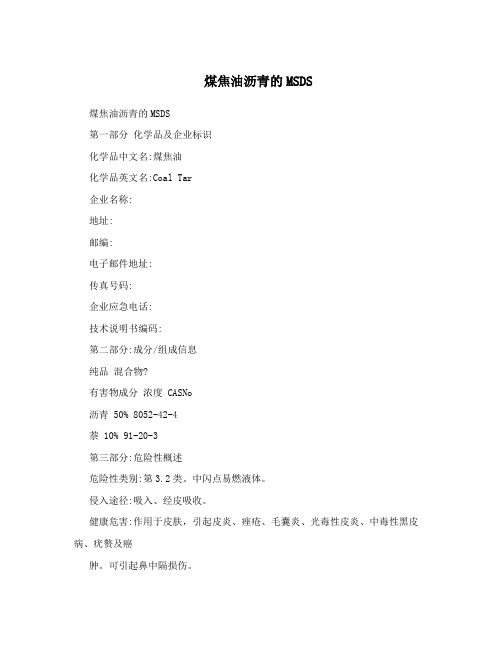
煤焦油沥青的MSDS煤焦油沥青的MSDS第一部分化学品及企业标识化学品中文名:煤焦油化学品英文名:Coal Tar企业名称:地址:邮编:电子邮件地址:传真号码:企业应急电话:技术说明书编码:第二部分:成分/组成信息纯品混合物?有害物成分浓度 CASNo沥青 50% 8052-42-4萘 10% 91-20-3第三部分:危险性概述危险性类别:第3.2类。
中闪点易燃液体。
侵入途径:吸入、经皮吸收。
健康危害:作用于皮肤,引起皮炎、痤疮、毛囊炎、光毒性皮炎、中毒性黑皮病、疣赘及癌肿。
可引起鼻中隔损伤。
环境危害:对环境有危害,对大气可造成污染。
燃爆危险:本品易燃,为致癌物。
第四部分:急救措施8皮肤接触:脱去污染的衣着,用肥皂水和清水彻底冲洗皮肤。
眼睛接触:提起眼睑,用流动清水或生理盐水冲洗。
就医。
吸入:迅速脱离现场至空气新鲜处。
保持呼吸道通畅。
如呼吸困难,给输氧。
如呼吸停止,立即进行人工呼吸。
就医。
食入:尽快彻底洗胃,就医。
第五部分:消防措施危险特性:其蒸汽与空气可形成爆炸性混合物,遇明火、高热极燃烧爆炸,与氧化剂接触猛烈反应,若遇高热,容器内压增大,有开裂或爆炸的危险。
有害燃烧产物:一氧化碳、二氧化碳。
灭火方法:消防人员必须佩戴过滤式防毒面具(全面罩)或隔离式呼吸器,穿全身防火防毒服,在上风向灭火,尽可以将容器从火场移至空旷处,喷水保持火场容器冷却,直至灭火结束。
处在火场中的容器若已变色或从安全泄压装置中产生声音,必须马上撤离,灭火剂:雾状水、泡沫、干粉、二氧化碳、砂土。
第六部分:泄漏应急处理应急处理:迅速撤离泄露污染区人员至安全区,并进行隔离,严格限制出入。
切断火源,建议应急处理人员佩戴自给正压式呼吸器,穿防毒服。
尽可能切断泄漏源,防止流入下水道、排洪沟等限制性空间。
小量泄露:用砂土或其它不燃材料吸附或吸收。
大量泄露;构筑围堤或挖坑收容,用泡沫覆盖,降低蒸汽危害,用泵转移至槽车或专门收集容器内,回收或运至废物处理场所处理。
氰化物操作规程
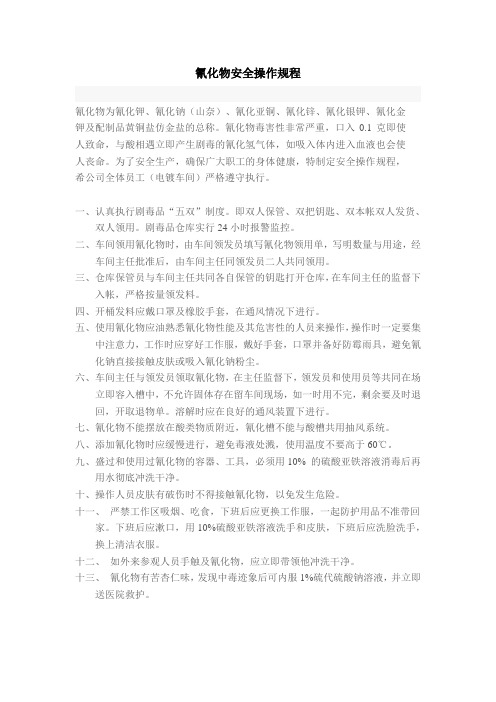
氰化物安全操作规程氰化物为氰化钾、氰化钠(山奈)、氰化亚铜、氰化锌、氰化银钾、氰化金钾及配制品黄铜盐仿金盐的总称。
氰化物毒害性非常严重,口入0.1克即使人致命,与酸相遇立即产生剧毒的氰化氢气体,如吸入体内进入血液也会使人丧命。
为了安全生产,确保广大职工的身体健康,特制定安全操作规程,希公司全体员工(电镀车间)严格遵守执行。
一、认真执行剧毒品“五双”制度。
即双人保管、双把钥匙、双本帐双人发货、双人领用。
剧毒品仓库实行24小时报警监控。
二、车间领用氰化物时,由车间领发员填写氰化物领用单,写明数量与用途,经车间主任批准后,由车间主任同领发员二人共同领用。
三、仓库保管员与车间主任共同各自保管的钥匙打开仓库,在车间主任的监督下入帐,严格按量领发料。
四、开桶发料应戴口罩及橡胶手套,在通风情况下进行。
五、使用氰化物应油熟悉氰化物性能及其危害性的人员来操作,操作时一定要集中注意力,工作时应穿好工作服,戴好手套,口罩并备好防霉雨具,避免氰化钠直接接触皮肤或吸入氰化钠粉尘。
六、车间主任与领发员领取氰化物,在主任监督下,领发员和使用员等共同在场立即容入槽中,不允许固体存在留车间现场,如一时用不完,剩余要及时退回,开取退物单。
溶解时应在良好的通风装置下进行。
七、氰化物不能摆放在酸类物质附近,氰化槽不能与酸槽共用抽风系统。
八、添加氰化物时应缓慢进行,避免毒液处溅,使用温度不要高于60℃。
九、盛过和使用过氰化物的容器、工具,必须用10% 的硫酸亚铁溶液消毒后再用水彻底冲洗干净。
十、操作人员皮肤有破伤时不得接触氰化物,以免发生危险。
十一、严禁工作区吸烟、吃食,下班后应更换工作服,一起防护用品不准带回家。
下班后应漱口,用10%硫酸亚铁溶液洗手和皮肤,下班后应洗脸洗手,换上清洁衣服。
十二、如外来参观人员手触及氰化物,应立即带领他冲洗干净。
十三、氰化物有苦杏仁味,发现中毒迹象后可内服1%硫代硫酸钠溶液,并立即送医院救护。
乙醛Acetaldehyde醋酐Acetic#anhydrdie均四溴乙烷Acetylene tetrabromide乙酰水杨酸Acetylsalicylic acid(Aspirin)艾氏剂(皮) Aldrin烯丙醇(皮) Aliyl alcohol氯丙烯Allyl chloride烯丙基缩水甘油醚(皮) Allyl glycidyl ether(AGE) 烯丙基丙基二硫醚Allyl propyl disulfideα—氧化铝α-Alumina铝Aluminum金属铝及氧化物Metal & oxide制造烟火用的铝粉Fyro powders可溶性盐类Soluble salts烷基化合物Alkyls4—氨基联苯(皮) 4-Aminodiphenyl2—氨基吡啶2-Aminopyridine杀草强Amitrol氯化铵烟Ammonium chloride fume全氟辛醇铵酯Ammonium perfluorooctanoate氨基磺酸铵Ammonium sulfamate醋酸正戊酯n—Amyl acetate醋酸仲戊酯sec-Amyl acetate苯胺及同系物(皮) Aniline & homologues茴香胺(邻位、对位异构体)(皮) Anisdine(o-p-isomers)锑及其化合物(按Sb计) Antimony & compounds三氧化锑Antimony trioxide加工和使用(按Sb计) Handling and use制造Production安妥ANTU砷及其可溶性化合物(按As计) Arsenic & soluble compounds 三氧化二砷制造Arsenic trioxide production砷化氢Arsine沥青(石油)烟Asphalt(Petroleum)fumes阿特拉津Atrazine谷硫磷(皮) Azinphos-methyl钡,可溶性化合物(按Ba计) Barium,Soluble compounds硫酸钡Barium sulfate苯菌灵Benomyl联苯胺(皮) Benzidine苯甲酰过氧化物Benzoyl perozide苯并(a)芘Benzo(a)pyrene苄基氯Benzyl chloride铍及其化合物Berylliufn and compounds联苯Biphenyl碲化铋Bismuth telluride含硒的Se-doped四硼酸钠盐Borates.tetra,sodium salts无水Anhydrous十水合物Decahydrate五水合物Pentahydrate氧化硼Boron oxide三溴化硼Boron tribromide三氟化硼Boron trifluoride除草定Bromacil溴Bromine五氟化溴Bromine pentafluoride溴仿(皮) Bromoform1,3—丁二烯1,3-Butadiene丁烷Butane2—丁氧基乙醇(皮) 2-Butoxyethanol醋酸正丁酯n-Butyl acetate醋酸仲丁酯sec-Butyl acetate醋酸叔丁酯tea-Butyl aeetlate丙烯酸丁酯Butyl acrylate正丁醇(皮) n-Butyl alcohol仲丁醇sec-Butyl alcohol叔丁醇tert-Butyl alcohol了胺(皮) Butylamine叔丁基铬酸酯(皮)(按CrO3计) tert-Butylchromate 正丁基缩水甘油醚n-Butyl glycidyl ether(BGE) 乳酸正丁酯n-Butyl lactate丁硫醇Butyl mereaptan邻仲丁基苯酚(皮) o-sec-Butylphenol对叔丁基甲苯p-tert-Butyltoluene碳酸钙Calcium carbonate氰氨化钙Calcium cyanamide氢氧化钙Calcium hydroxide氧化钙Calcium oxide硅酸钙Calcium silicate硫酸钙Calcium sulfate樟脑(合成) Camphor,synthetic敌菌丹(皮) Captafol克菌丹Captah西维因Carbaryl呋喃丹Carhofuran碳酰氟Carbonyl fluoride氢氧化铯Cesium hydroxide氯丹(皮) Chlordane氯代茨烯(皮) Chlorinated camphene氯代二苯醚Chlorinated diphenyl oxide 二氧化氯Chlorine dioxide三氟化氯Chorine trifluoride氯乙醛Chloroacetaldehyde氯丙酮(皮) Chloroaeetoneα—氯乙酰苯α—Chloracetophenone氯乙酰氯Chloroacetyl chloride邻氯苄叉丙二腈(皮) o-Chlorbenzylidene malononitrile氯溴甲烷Chlorobromomethane氯二氟甲烷Chlordifluoromethane氯联苯(42%氯)(皮) Chlorodiphenyl氯联苯(54%氯)(皮) Chlorodiphenyl双氯甲醚bis(Chloromethyl)ether氯甲甲醚Chloromethyl methyl ether1—氯—1—硝基丙烷1-Chloro-1-nitropropane氯五氟乙烷Chloropentafluoroethane邻氯苯乙烯o-Chlorostyrene邻氯甲苯o-Chlorotoluene毒死蜱(皮) Chlorpyrifus铬铁矿石加工(铬酸盐)(按Cr计) Chromite ore processing(Chromate) 铬Chromium金属铬Metal铬二价化合物(按Cr计) Chromium(Ⅱ)compounds铬三价化合物(按Cr计) Chromium(Ⅲ)compounds铬六价化合物(按cr计) Chromium(Ⅳ)compounds水溶性的Watersoluble某些不溶于水的Certain water insoluble铬酰氯;二氯二氧化铬Chromyl chloride二氯二甲吡啶酚Clopidol煤焦油沥青挥发物(按苯溶解物计) Coal tar pitch volatiles钴(按Co计) Cobalt金属尘和烟Metal dust & fume羰基钴(按Co计) Cobalt carbonyl氢羰基钴(按Co计) Cobalt hydrocarbonyl 铜Copper烟Fume粉尘和雾(按Cu计) Dusts & mists巴豆醛Crotonaldenyde育畜磷Crofomate异丙苯(皮) Cumene氯基氰Cyanamide氰化物(按CN计)(皮) Cyanides氰Cyanogen氯化氰Cyanogen chloride环己醇(皮) Cyclohexanol环己烯Cyclohexene环己胺Cyclohexylamine旋风炸药(皮) Cyelonite环戊二烯Cyclopentadiene环戊烷Cyclopentane杀螨锡Cyhexatin2,4—滴2,4—D癸硼烷(皮) Deeaborane双丙酮醇Diacetone alcohol二嗪农(皮) Diazinon重氮甲烷Diazomethane乙硼烷Diborane2—N—二丁胺基乙醇(皮) 2-N-Dibutylaminoethanol磷酸二丁酯Dibutyl phosphate酞酸二丁酯Dibutyl phthalate二氯代乙炔Dichloroacetylene邻二氯苯o-Dichlorobenzene对二氯苯p-Dichlorobenzene3,3-二氯联苯胺(皮) 3,3-Dichlorobenzidine二氯二氟甲烷Dichlorodifiuoromethane1,3-二氯-5,5-二甲基海因1,3-Dichloro-5,5-dimethylhy-dantoin 1,1-二氯乙烷1,1-Dichloroethane1,2—二氯乙烯1,2-Dichloroethylene二氯乙醚(皮) Dichloroethyl ether二氯氟甲烷Dichlorofluoromethane1,1-二氯-1-硝基乙烷1,1-Dichloro-1-nitroethane二氯丙烯(皮) Diehloropropene2,2—二氯丙酸2,2-Dichloropropionic acid二氯四氟乙烷Dichlorotetrafiuoroethane百治磷(皮) Dicrotophos二聚环戊二烯;双茂Dicyelo pentadiene二茂铁Dicyclopentadienyl iron狄氏剂(皮) Dieldrin二乙醇胺Diethanolamine二乙胺Diethylamine2-二乙胺基乙醇(皮) 2-Diethylaminoethanol二乙撑三胺(皮) Diethylene triamine二乙基甲酮;戊酮-[3] Diethyl ketone酞酸二乙酯Diethyl Phthalate二氟二溴甲烷Difluorodibromomethane二缩水甘油醚Didycidyl ether(DGE)二异丁基甲酮Diisobutyl ketone二异丙胺(皮) Diisopropylamine二甲基乙酰胺(皮) Dimethyl acetamide二甲苯胺(皮) Dimethylaniline二甲基氨基甲酰氯Dimethyl carbamoyl chloride 二甲基甲酰胺(皮) Directhylformamide1,1-二甲基肼(皮) 1,1-Dimethlyhydrazine酞酸二甲酯Dimethylphthalatel硫酸二甲酯(皮) Dimethyl sulfate二硝基甲苯酰胺Dinimlmide二硝基苯(各种异构体)(皮) Dinitrobenzene二硝基邻甲酚(皮) Dinitro-o-cresol二硝基甲苯(皮) Dinitrotoluene二嗯烷(皮) Dioxane二噁硫磷(皮) Dioxathion二苯胺Diphenylamine二丙二醇甲醚Dipropylene glyeol methyl ether 二丙基甲酮Dipropyl ketone杀草快Diquat二仲辛基酞酸酯Di-sec-octyl phthalate双硫醒Disulfiram乙拌磷Disulfoton2,6-二叔丁基对甲酚2,6-D-itert-butyl-p-cresol 敌草隆Diuron二乙烯基苯Divinyl benzene硫丹(皮) Endosulfan异狄氏剂(皮) Endrin氟甲氧氟烷Enflurane环氧氧丙烷(皮) Epichlorohydrin苯硫磷(皮) EPN乙醇胺Ethanolamine乙硫磷(皮) Ethion2-乙氧基乙醇(皮) 2-Ethoxyethanol2-乙氧基乙基醋酸酯(皮) 2-Ethoxyethyl acetate 丙烯酸乙酯(皮) Ethyl acrylate乙醇Ethyl alchol乙基戊基甲酮Ethyl amyl ketone溴乙烷Ethyl bromide乙基丁基甲酮Ethyl butyl ketone氯乙烷Ethyl chloride1,2-二漠乙烷(皮) Ethylene dibromide 1,2-二氯乙烷Ethylerie dichloride乙二醇<蒸气) Ethylene glycol(Vapor)乙二醇硝酸酯(皮) Ethylene glycol dinitrte 乙撑亚胺(皮) Ethylenimine甲酸乙酯Ethyl formate乙叉降冰片烯Ethylidene norbornene乙硫醇Ethyl mercaptanN-乙基吗啉(皮) N-Ethylmorpholine硅酸乙酯Ethyl silicate克线磷(皮) Fenamiphos辛索磷Fensuffothion倍硫磷(皮) Fenthion福美铁Ferbam氟化物(按F计) Fluorides氟Fluonne地虫磷(皮) Fonofos甲酰胺(皮) Formamide甲酸Formic acid糖醇(皮) Fuffurylalcohol四氢化锗Germaniumtetrahrdride戊二醛Glutaraldehyde甘油雾C1yeerin mist缩水甘油Glyeidol铪Hafnium三氟溴氯乙烷Halothane七氯(皮) Heptaehlor庚烷(正庚烷) Heptane(n-Heptane)六氯二丁烯(皮) Hexachlorobutadiene六氯环戊二烯Hexachlorocyclopentadiene六氯乙烷Hexachloroethane六氯萘(皮) Hexachloronaphthalene六氟丙酮(皮) Hexafluoroacetone环己烷二异氰酸盐Hexamethrlerie diisocyanate 六甲基磷酸酰胺(皮) Hexamethyplhosphoramide 己烷(正己烷) Hexane(n-Hexane)其他异构体Other isomem仲己基醋酸酯sec-Hexyl acetate己二醇Hexylene glycol氢化三联苯Hydrogena tedterphenyls溴化氢Hydrogen bromide氯化氢HYdrogen chloride氟化氢(按F计) Hydrogen fluoride过氧化氢Hydrogen peroxide硒化氢(按Se计) Hydrogen selenide氢醌Hydroquinone2-羟丙基丙烯酸酯(皮) 2-Hydroxypropyl acrylate 茚Indene铟及其化合物(按In计) Indium & compounds碘仿Iodoform五羧基铁(按Fe计) Iron pentacarbonyl可溶性铁盐(按Fe计) Iron salts,soluble醋酸异戊酯Isoamyl acetate异戊醇isoamyl alcohol醋酸异丁酯Isobutyl acetate异丁醇Isobutyl alcohol异辛醇(皮) Isooctyl alcohol异佛尔酮Isophorone异佛尔酮二异氰酸酯(皮) Isophorone diisocyanate 异丙氧基乙醇Isopropoxyethanol醋酸异丙酯Isopropyl acetate异丙醇lsopropyl alcohol异丙胺IsopropylamineN-异丙基苯胺(皮) N-Isopropylaniline异丙醚Isopropyl ether异丙基缩水甘油醚Isopropyl glycidyl ether(IGE) 乙烯酮Ketene铅(无机) Lead,inorganic粉尘和烟(按Pb计) dusts & fumes砷酸铅(按Pbs(AaO4)2计) Lead arsenate铬酸铅(按Cr计) Lead chromate林丹(皮) Lindane马来酐Maleic anhydride茂基三羰基锰(按Mn计)(皮) Manganese cyclopentadienyl triearbonyl莱基氧化物Mesityl oxide甲基丙烯酸Methacrylic acid灭多虫Methomyl甲氧氯Methoxychlor2-甲氧基乙醇(皮) 2-Methoxyethanol2-甲氧基乙基醋酸酯(皮) 2-Methoxyethyl acetate4—甲氧基苯酚4-Methoxyphenol甲基乙炔Methyl acetylene丙炔与丙二烯混合物Methyl acetylene-propadiene mixture(MAPP)甲基丙烯腈(皮) Methylacrylonitrile甲缩醛Methylal甲基正戊基甲酮Methyl n-amyl ketoneN-甲基苯胺(皮) N-Methyl aniline溴油烷(皮) Methyl bromide甲基正丁基甲酮Methyl n-bulyl ketone甲基氯仿Methyl chloroform甲基-2-氰基丙烯酸酯Medlyl-2-Cyanoacrylate甲基环己烷Methylcyclchexane甲基环己醇Methlcyclohexanol邻甲基环己酮(皮) o-Methylcyclohexamone2-甲基茂基三羰基锰(按Mn计)(皮) 2-Methylcyclopentadienyl mangaese tficarbonyl 甲叉双苯基异氰酸酯Methylene bisphenyl isocyanate(MDI)4,4-甲叉双(2-氯苯胺)(皮) 4,4-Methylerie bis(2-chloroaniline) 甲叉双(4-环己基异氰酸酯) Methylene bis(4-cyclohexylisocyanate) 4,4’-甲撑替二苯胺(皮) 4,4’-Methylene dianiline甲基乙基甲酮Methyl ethyl ketone(MEK)甲基乙基甲酮过氧化物Methyl ethyl ketone peroxide甲酸甲酯Methyl formate甲基肼(皮) Methyl hydrazine碘甲烷(皮) Methyl iodide甲基异戊基甲酮Methyl isoamyl ketone甲基异丁基甲醇(皮) Methyl isobutyl carbinol甲基异丁基甲酮Methyl isobutyl ketone异氰酸甲酯(皮) Methyl isocyanate甲基异丙基甲酮Methyl isopropyl ketone甲硫醇Methyl mercaptan甲基丙烯酸甲酯 Methyl methacrylate甲基丙基甲酮Methyl propyl ketone硅酸甲酯Methyl silicateα-甲基苯乙烯α-Methyl styrene赛克津Metribuzin速灭磷(皮) Mevinphos吗啉(皮) Morpholine三溴磷(皮) Naled萘Naphthaleneβ-萘胺β—Naphthylamine镍Nickel金属镍Metal不可溶性化合物(按Ni计) Insoluble compounds 可溶性化合物(按Ni计) Soluble compounds烟碱(皮) Nicotine四氯草定Nitrapyrin硝酸Nitric acid一氧化氮Nitric oxide对硝基苯胺(皮) p-Nitroaniline硝基苯(皮) Nitrobenzene对硝基氯苯(皮) p-Nitroehlorobenzene4-硝基联苯4-Nitrodiphenyl硝基乙烷Nitroethane二氧化氮Nitrogen dioxide三氟化氮Nitrogen trifluoride Nitroglycerin(NG) 硝基甲烷Nitromethane1—硝基丙烷1-Nitropropane2—硝基丙烷2-NitroproaneN—亚硝基二甲胺(皮) N-Nitrosodime thylamine 硝基甲苯(皮) Nitrotolune一氧化二氮Nitrous oxide壬烷Nonane八氯萘(皮) Octaehloronaphthalene辛烷Octane四氧化锇(按Os计) Osmium tetroxide二氟化氧Oxygen difluoride百草枯(呼吸性粉尘) Paraquat戊硼烷Pentaborane五氯萘PentachloronaPhthalene五氯酚(皮) Pentaehlorophenol季戊四醇Pentaerythritol戊烷Pentane全氯乙烯Perehloroethylene全氯甲酸醇Perchloromethyl mrcaptan过氯酰氟Perchloryl fluoride苯酚(皮) Phenol吩噻嗪(皮)PhenothiazineN—苯基-β-萘胺N-Phenyl-beta-naphthylamine 对苯二胺(皮) p-Phenylene diamine苯醚蒸气Phenyl ether vapor苯基缩水甘油醚Phenyl elyeidyl ether(PGE) 苯肼(皮) Phenylhydrazine苯硫醇Phenyl mereaplan苯膦Phenylphosphine磷化氢Phosphine磷酸Phosphoric acid黄磷Phosphorus(yellow)磷酰氯;三氯氧磷Phosphorus oxychloride五氯化磷Phosphorus pentachloride五硫化二磷Phosphorus pentasulfide三氯化磷Phosphorus trichloride酞酐Phthalic anhlydride间酞二腈m-Phthalodinitrile毒莠定Picloram苦味酸(皮) Hefic acid杀鼠酮Pindone二盐酸哌嗪Piperazine dihydroehloride铂Platinum金属铂Metal可溶性盐类(按Pt计) Soluble salts氢氧化钾Potassium hydroxide丙烷磺内酯Propane suhone炔丙醇(皮) Propargyl alcoholβ-丙内酯β-Propiolactone丙酸Propionic acid残杀威Propoxur醋酸正丙酯n-propyl acetate氯化丙烯;二氯丙烷Propylene dichloride丙二醇二硝酸酯(皮) Propylene glycol dinitrate丙二醇一甲基醚Propylene glycol monomethyl ether 丙撑亚胺(皮) Propylene imine氧化丙烯;环氧丙烷Propylene oxide硝酸正丙酯n-Propyl nitrate除虫菊Pyrethrum苯醌Quinone间苯二酚Resoreinol铑Rhodium金属铑Metal不溶性化合物(按Rh计) Isoluble compounds 可溶性化合物(按Rh计) Soluble compounds 皮蝇磷Ronnel鱼藤酮(商品) Rotenone(commercial)铁丹Rouge橡胶溶剂(石脑油) Rubber solvent(Naphtha)硒化合物(按Se计) Selenium compounds六氟化硒(按Se计) Selenium hexafluoride2,4-滴硫钠Sesone硅Silicon碳化硅Silicon carbide四氢化硅Silicontetrahydride银(按Ag计) Silver金属银Metal可溶性化合物Soluble compounds亚硫酸氢钠Sodium bisulfite氟醋酸钠(皮) Sodium fluoroaeetate氢氧化钠Sodium hydroxide偏亚硫酸氢钠Sodium metabisulfite硬脂酸盐Stearates锑化氢Stibine番木鳖碱;马钱子碱Strychnine枯草菌素Subtilisins(蛋白水解酶,按100%纯结晶酶计) (Proteolytic enzymes as 100%pure crystalline enzyme) 硫特昔(皮) Sulfotep六氟化硫Sulfur hexafluoride一氯化硫Sulfur monochloride五氟化硫Sulfur pentafluoride四氟化硫Sulfur tetrafiuoride硫酰氟Sulfuryl fluoride甲硫硫磷(编者注:可能是“甲硫磷”)Sulprofos2,4,5-涕2,4,5-T碲及其化合物(按Te计) Tellurium & compounds六氟化碲(按Te计) Telmrium hexafluorid双硫磷Temephos特昔(皮) TEPP联三苯Terphenyls1,1,1,2—四氯-2,2—二氟乙烷1,1,1,2-Tetrachloro-2,2-difiuoroethane1,1,2,2—四氯—1,2-二氟乙烷1,1,2,2-Tetraehloro-1,2-difluoroethane1,1,2,2—四氯乙烷(皮) 1,1,2,2-Tetrachloroehane四氯萘Tetraehloronaphthalene Tetraethyl lead四甲基铅(按Pb计)(皮) Tetramethyl lead四甲基琥珀腈(皮) Tetramethyl sueeinonitrile四硝基甲烷Tetranitromethane焦磷酸四钠Tetrasodium pyrophosphate特屈儿(皮) Tetryl铊Thallium可溶性化合物(按Tl计)(皮) Soulble compounds4,4’-硫代双(6-叔丁基间甲酚) 4,4’-Thiobis(6-tert-butyl-m-eresol)巯基醋酸(皮) Thioglycolic acid亚硫酸氯Thionyl chloride福美双Thiram锡Tin金属锡Metal氧化物和无机化合物(除SnH4外)(按Sn计) Oxide & inorganic compounds 有机化合物(按Sn计)(皮) Organic Compounds二氧化钛Titanium dioxide邻联甲苯胺(皮) o-Tolidine邻甲苯胺(皮) o-Toluidine间甲苯胺(皮) m-Toluidine对甲苯胺(皮) p-Toluidine三丁基磷酸酯Tributyl phosphate三氧醋酯Trichloroacetic acid1,2,4—三氯苯1,2,4-Trichlorobenzene1,1,2-三氯乙烷(皮) 1,1,2-Trichloroethane三氯乙烯Trichloroethylene三氯氟甲烷Trichlorofluoromethane三氯萘(皮) Trichloronaphthalene1,2,3—三氯丙烷(皮) 1,2,3-Trichloroprepane1,1,2—三氯—1,2,2—三氟乙烷1,1,2-Triehloro-I,2,2-trifiuorethane 三乙胺Triethylamine三氟溴甲烷Trifluorobromomethane苯偏三甲酸酐Trimellitie anhydride三甲胺Trimethylamine三甲苯Trimethyl benzene亚磷酸三甲酯(皮) Trimethyl phosphite2,4,6—三硝基甲苯(皮) 2,4,6-Trinitrotoluene(TNT)三邻甲苯磷酸酯(皮) Triorthoeresyl phosphate三苯胺Triphenyl amine磷酸三苯酯Triphenyl phosphate钨(按W计)Tungsten不溶性化合物Insolublecompounds可溶性化合物Soluble compounds铀(天然) Uranium(natural)可溶性和不溶性化合物(按U计) Soluble & insoluble compounds正戊醛n-Valeraldehyde醋酸乙烯酯Vinyl acetate溴乙烯Vinyl bromide二氧化乙烯基环己烯(皮) Vinyl cyclohexene dioxide乙烯叉二氯;偏二氯乙烯Vinylidene chloride乙烯基甲苯Vinyl toluene油漆涂料用石脑油VM & P Naphtha 杀鼠灵Warfarin。
煤焦油软沥青的流变学行为研究

煤焦油软沥青的流变学行为研究摘要流变行为是材料在熔融态和流动状态形变时的表现。
它主要研究材料在应力、应变、温度、湿度、辐射等条件下与时间因素有关的变形和流动的规律。
煤焦油软沥青是一种结构和组成非常复杂的混合物,其分子量和分子结构各不相同,煤焦油软沥青的性质是这些不同组分的综合反映。
本文以煤焦油软沥青为原料,通过反应釜对其进行空气氧化改质,得到4种软化点不同的改质沥青。
分析改质沥青的软化点、甲苯不溶物、喹啉不溶物、结焦值和灰分等性能指标,并关联它们与软化点之间的内在关系;接着在高温流变仪上研究原料软沥青、4种改质沥青的流变学性能,评价在不同转速和温度下试样的粘度变化情况,获得粘温曲线,研究沥青流体的流变性能;根据试样的粘温曲线数据,计算不同软化点煤沥青的粘流活化能;为悬浮法或乳化法制备沥青微球的提供理论依据和数据。
实验表明,煤焦油软沥青的粘度随温度的增大而逐渐减小,随剪切应力的增大逐渐减小,并且温度和剪切应力越大,对煤焦油沥青的影响越小。
关键词:煤焦油软沥青;流变行为;粘温曲线Rheological behavior of soft coal tarpitchAbstractRheological behavior of the material in the molten state when the state of deformation and flow performance. It mainly studies the material under stress, strain, temperature, humidity, radiation and other conditions of the law of the deformation and flow of time-related factors. Soft coal tar pitch is a very complex mixture of structure and composition, the molecular weight and molecular structure varies, the nature of soft coal tar pitch is a comprehensive reflection of these different components. In this paper, soft coal tar pitch as a raw material, in this paper, soft coal tar pitch as a raw material, its modification by air oxidation reactor, to obtain four kinds of softening point different modified bitumen. Analysis of modified bitumen softening point, toluene insoluble, quinolone insolubles and ash coking values and other performance indicators, and associate them with the softening point of the intrinsic relationship between; Then study materials soft asphalt, rheological properties of four kinds of modified asphalt at high temperature rheometer, viscosity was evaluated at different speeds and temperatures of the sample, obtain viscosity-temperature curve, rheological properties of bitumen fluid; According to data of the sample viscosity-temperature curve, Calculate different softening point coal tar viscous flow activation energy; A suspension or emulsified asphalt prepared microspheres provide a theoretical basis and data. Experimental results show that the viscosity of the soft coal tar pitch with increasing temperature and decreases, With increasing shear stress decreases, and the temperature and shear stress, the smaller the impact on coal tar pitch.Key words:Soft coal tar pitch; Rheological behavior; Viscosity-temperature curve目录1 绪论1.1前言1.2流体的定义及特征1.2.1流体的基本概念1.2.2流体的流变性能特征1.2.3流体流变性能的测定方法1.3 煤沥青的流变学研究1.3.1煤沥青的性质1.3.2煤沥青的种类1.3.3煤沥青的应用1.3.4煤沥青粘度与温度的关系1.3.5煤沥青粘度的影响因素1.3.6煤沥青流变性能的研究进展1.4课题的立题依据和研究内容2 实验部分2.1实验原料及试剂2.2实验仪器2.3试样的制备2.4试样性质的测定2.41软化点的测定2.4.2甲苯不溶物的测定2.4.3喹啉不溶物的测定2.4.4结焦值的测定2.4.5灰分的测定2.5粘度的测定2.5.1粘度计操作流程2.5.2粘度计参数设置2.5.3 注意事项3 结果与讨论3.1 四组试样的性质3.2温度对粘度的影响粘流活化能3.3转速(剪切应力)对粘度影响3.3.1软沥青不同转速下的粘度曲线3.3.2试样1不同转速下的粘度曲线3.3.3试样2不同转速下的粘度曲线3.3.4试样3不同转速下的粘度曲线3.3.5试样4不同转速下的粘度曲线4 结论致谢参考文献1绪论1.1前言近几年以来,流变学作为研究物质流动和其运动过程中发生形变规律的科学,在许多领域得以应用。
煤焦油沥青及其乳化

煤焦油沥青及其乳化煤焦油沥青是用煤、褐煤等有机物质,在隔绝空气和高温下进行干馏、冷凝其挥发物质而获得粘稠状液体,再经加工而制得的沥青类材料。
它是制取乳化煤焦油沥青的主要原材料,也是在建筑和道路上应用较早的建筑防水材料和铺筑路面材料。
一、分类煤焦油按生产煤焦油沥青的原材料不同,可分为煤沥青和页岩沥青。
页岩沥青是由云母页岩提炼石油后的页岩残渣,经加工而制得的沥青类物质。
还有木材干馏和气化时制得的木沥青。
泥炭煤经干馏而得到的泥炭沥青。
其中制作乳化煤焦油沥青中应用最多的为煤沥青。
按照煤焦油沥青的稠度不同,可分为软煤沥青和硬煤沥青。
软煤沥青是蒸馏煤焦油过程中,只馏出部分轻油,中油不完全馏出,或在硬煤沥青中掺入蒽油等制得的液体或半液体的沥青类材料。
硬煤沥青是高温煤焦油经蒸馏出轻油、中油、重油和蒽油等而制得的脆硬而没有弹塑性的固体或半固体的沥青类物质。
乳化煤焦油沥青中应用最多的为软煤沥青。
按照煤焦油沥青的用途不同,可分为低温煤沥青、中温煤沥青和高温煤沥青、筑路油等。
中温煤沥青又分为电极煤沥青和一般煤沥青。
在建筑和道路上应用最多的为筑路油。
二、组分与结构煤焦油沥青是极其复杂的碳氢化合物,其主要元素是碳和氢,含碳量较一般石油沥青高得多,超过90%,还含有2、硫、氮等元素。
煤焦油沥青的化学结构极为复杂,可分离为数千种至数万种结构单元。
在研究煤焦油沥青的化学性质上,常常将煤焦油沥青划分为几个化学性质相近,技术上有一定联系的组分。
B.V.葛列米尔将煤焦油沥青划分为游离碳、硬树脂、软树脂和油分。
煤焦油沥青中的游离碳是高分子有机化合物的固态碳质微粒,不溶于任何溶剂,有很好的稳定性,只是在高温下才能分解。
游离碳含量的多少,直接影响这煤焦油沥青的粘滞性。
游离碳含量增加,粘滞性增加,密度亦增加,温度稳定性增强,脆性增大。
如果游离碳高于某一限度时,性能变坏,其含量必须加以控制。
煤焦油沥青中的树脂质是含氧的环式碳氢化合物。
根据其粘滞度的大小,可分为软树脂和硬树脂,软树脂为赤褐色的塑性物质,溶于苯和二氯甲烷;在氧气、温度和日光作用下,发生氧化和聚合作用,由粘稠液体变为固体;在硫酸作用下,转变为溶于水的物质,又称为可溶性树脂。
煤焦油的理化性质及危险特性表

饱和蒸汽压(k Pa)
无资料
引燃温度(℃)
无资料
爆炸上限/下限[%(V/V)]:
无资料
临界压力(MPa)
无资料
临界温度(℃)
无资料
主要用途
可分馏出各种芳香烃、烷烃、酚类等,也可制取油毡、燃料和炭黑。
溶解性
微溶于水,溶于苯、乙醇、乙醚、氯仿、丙酮等多数有机溶剂。
毒性健康危害
毒性
无资料
健康危害
作用于皮肤,引起皮炎、痤疮、毛囊炎、光毒性皮炎、中毒性黑皮病、疣赘及肿瘤。可引起鼻中隔损伤。国际癌症研究中心(IARC)已确认为致癌物。
储运注意事项
储存注意事项:
储存于阴凉、通风仓间内。远离火种、热源。防止阳光直射。保持容器密封。应与氧化剂、酸类分开存放。禁止使用易产生火花的机械设备和工具。搬运时要轻装轻卸,防止包装及容器损坏。
②运输注意事项:
本品铁路运输时限使用钢制企业自备罐车装运,装运前需报有关部门批准。也铁路运输时,钢桶包装的可用敞车运输。铁路运输时应严格按照铁道部《危险货物运输规则》中的危险货物配装表进行配装。运输时运输车辆应配备相应品种和数量的消防器材及泄漏应急处理设备。夏季最好早晚运输。运输时所用的槽(罐)车应有接地链,槽内可设孔隔板以减少震荡产生静电。严禁与氧化剂、食用化学品等混装混运。运输途中应防曝晒、雨淋,防高温。中途停留时应远离火种、热源、高温区。装运该物品的车辆排气管必须配备阻火装置,禁止使用易产生火花的机械设备和工具装卸。公路运输时要按规定路线行驶,勿在居民区和人口稠密区停留。铁路运输时要禁止溜放。严禁用木船、水泥船散装运输。
泄漏处置
疏散泄漏污染区人员至安全区,禁止无关人员进入污染区,切断火源。建议应急处理人员戴自给式呼吸器,穿一般消防防护服。在确保安全情况下堵漏。喷水雾会减少蒸发,但不能降低泄漏物在受限制空间内的易燃性。用沙土或其它不燃性吸附剂混合吸收,收集运至废物处理场所处置。如大量泄漏,利用围堤收容,然后收集、转移、回收或无害处理后废弃。
MSDS Coal Tar Pitch化学品安全技术说明书(沥青).rtf

Material Safety Data Sheet Manufacturer Information:YAN KUANG CLAN CO.,LTDCOMPANY NAME ., LTDQINGDAO, CHINASECTION I - PRODUCTIDENTIFICATIONPRODUCT NAME: COAL TAR PITCHCHEMICAL NAME: Pitch, coal tar, high-temperaturePRODUCT USE: waterproofing; roofing; industrial anodes, cathodes and electrodes; specialty carbon productsCHEMICAL FAMILY: Aromatic HydrocarbonsFORMULA: See Section XIII - Comments for FORMULA.CAS NUMBER: 65996-93-2NFPA 704M/HMIS RATING: 2/2 HEALTH 1/1 FLAMMABILITY 1/1 REACTIVITY0 = Least 1 = Slight 2 = Moderate 3 = High 4 = ExtremeEMERGENCY OVERVIEW:A black solid with a slight aromatic odor, which intensifies into a tarry odor upon melting. Carcinogen, Toxic, Irritant, Sensitizer (skin).SECTION II - HEALTH/SAFETY ALERT WARNINGMAY CAUSE EYE IRRITATION AND BURNING.MAY CAUSE SKIN IRRITATION,A PHOTOTOXIC SKIN REACTION IN SUNLIGHT, AND SKIN DAMAGE. MAY CAUSE RESPIRATORY TRACT IRRITATION IF INHALED.MAY CAUSE DIGESTIVE TRACT IRRITATION IF INGESTED.CONTACT WITH HEATED MATERIAL MAY CAUSE THERMAL BURNS. CHRONIC OVEREXPOSURE (as defined by OSHA recommended standards)CAN CAUSE CANCER.TARGET ORGANS ARE THE SKIN, BLADDER, SCROTUM, LUNGS.RISK OF CANCER DEPENDS ON DURATION AND LEVEL OF EXPOSURE.AVOID PROLONGED OR REPEATED CONTACTWITH SKIN OR BREATHING DUST/FUMES/VAPORS.OBSERVE GOOD HYGIENE AND SAFETY PRACTICES WHEN HANDLING THIS PRODUCTDO NOT USE THIS PRODUCT UNTIL MSDS HAS BEEN READ AND UNDERSTOODTHIS PRODUCT CONTAINS A CHEMICAL KNOWN TO THE STATE OF CALIFORNIATO CAUSE CANCER AND REPRODUCTIVE HAZARDS.SECTION III - HEALTH HAZARDINFORMATIONEYE: Exposure to fumes, vapors, or dust may cause irritation and burning to the eyes. Reversible symptoms may include irritation, a burning sensation, intolerance to light, redness/swelling/tearing, and possible erosion of the surface of the cornea. Contact with heated material may cause thermal burns.SKIN: Contact with the skin can result in irritation which, when accentuated by sunlight, may result in a phototoxic skin reaction. Contact with heated material may cause thermal burns. Hot/molten pitch is a severe burn hazard. Prolonged and repeated skin contact in the absence of recommended hygiene practices may cause acne, folliculitis and more serious skin disorders such as changes in skin pigmentation, ulcerations, benign skin growths and skin cancer.INHALATION: Inhalation of fumes, vapors, or dust may cause temporary respiratory irritation.Acute respiratory effects caused by overexposure to coal tar pitch volatiles may include coughing, sneezing, and swollen or irritated nasal mucosa or sinuses. See "Other" below for "Inhalation Continued". INGESTION: Ingestion of coal tar pitch may cause irritation of thegastrointestinal tract followed by one or more of the following: nausea, vomiting, and abdominal discomfort.OTHER: Inhalation Continued: Inhalation of fumes or vapors in significant excess of the PEL/TLV may lead to systemic symptoms such as salivation; vomiting; respiratory difficulties; headache; loss of pupillary reflexes; central nervous system (CNS) effects such as dizziness, weakness, possible loss of coordination and collapse; cyanosis; hypothermia; and convulsions. SECTION IV - EMERGENCY AND FIRSTAIDPROCEDURESEYE CONTACT: Flush eyes immediately with large amounts of water for at least 15 minutes, occasionally lifting the eyelids. Seek medical aid immediately.SKIN CONTACT: For contact with molten product, do not remove contaminated clothing. Flush skin immediately with large amounts of cold water. If possible, Submerge area in cold water. Pack with ice. Seek medical aid immediately. For other contact, remove all contaminated clothing and wash exposed area thoroughly with nonabrasive soap and water, or a mild detergent.INHALATION: Remove subject from exposure area to fresh air immediately. If breathing is difficult, give oxygen. If breathing has stopped, administer artificial respiration (e.g., mouth-to-mouth). Seek medical aid immediately. INGESTION: If the person is conscious, first induce vomiting to prevent further absorption. DO NOT ATTEMPT TO GIVE ANYTHING BY MOUTH TO AN UNCONSCIOUS PERSON. Give oxygen if respiration is shallow. Immediately seek medical aid.SECTION V - FIRE AND EXPLOSIONHAZARDINFORMATIONFLASH POINT & METHOD: >190C (374F) PMCC AUTOIGNITION TEMP: >399C-750FFLAMMABLE LIMITS (% BY VOLUME/AIR): LOWER: NAUPPER: NAEXTINGUISHING MEDIA: Use dry chemicals, carbon dioxide, sand, foam, steam, or water fog.FIRE-FIGHTING PROCEDURES: Wear complete fire service protective equipment, including full-face MSHA/NIOSH approved self-contained breathing apparatus. Use water or water spray to cool fire-exposed containers and structures and to protect personnel. Water/fog can control unconfined pitch fires, but water may cause frothing or eruption in closed tanks.FIRE AND EXPLOSION HAZARDS: Coal tar pitch at elevated temperatures may generate vapors that may ignite in the presence of air and a source of ignition. Burning may emit hazardous fumes/vapors which can form flammable/explosive mixtures in air and which may be in concentrations greater than the recommended PEL/TLV. Air-borne pitch dust may form explosive mixtures with air. Cloud ignition temperature is 710C (1310F) minimum. Explosion concentration (dust) is 0.035 ounces/ft3 (1000 mg/0.03 m3). Closed containers may explode when exposed to extreme heat. Liquid (molten) pitch at elevated temperatures will sustain combustion.SENSITIVITY TO MECHANICAL IMPACT: noSENSITIVITY TO STATIC DISCHARGE: yes for solid pitch dustSECTION VI - SPILL, LEAK ANDDISPOSALINFORMATIONSPILL OR LEAK PROCEDURES (PRODUCT): Avoid breathing vapors or contact with skin and eyes. Remove all ignition sources. Try to stop the source of the leak if possible without hazard. Ventilate the area if spill occurs indoors. Release or spillage of solid can be treated as a coal spillage and recovery made avoiding skin and eye contact. Shovel into dry, labeled containers and secure cover. Contain runoff of fire control water. If hot liquid is spilled, contain by diking/berming with absorbent solids, such as sand, ashes, earth, or other inert material as necessary to prevent entry into sewers or open bodies of water. Avoid contact with hot liquid/fumes/vapors. Provide cleanup personnel with appropriate protective clothing. In cases involving release to the environment in the U.S., report the release to The National Response Center at 1-800-424-8802. In Canada, report releases to provincialenzo(a)pyrene in coal tar pitch as determined from the analyses presented in Section VII and thereportable quantity for Benzo(a)pyrene of one pound, a CERCLA (Superfund)release of approximately 7 gallons (74 pounds) of coal tar pitch requires National Response Center notification. See Section I for listing of additional hazardous substances.WASTE DISPOSAL: If disposing in a state other than California, dispose of as an industrial waste in accordance with local, state, and federal regulations. Place in tightly sealed labeled containers. This product contains coal tar constituents, which have been determined by IARC to be a carcinogen. According to California hazardous waste regulations, substances posing a hazard to human health because of carcinogenicity are hazardous wastes. Dispose of as a hazardous waste in the state of California. In Canada, dispose of the material in accordance with provincial regulations.SECTION VII - RECOMMENDEDEXPOSUREExposure Limits:OSHA PEL:0.2 mg/m3 as 8-hr TWA(coal tar pitch volatiles)ACGIH TLV:0.2 mg/m3 as 8-hr TWA(coal tar pitch volatiles)SECTION VIII - PERSONALPROTECTION INFORMATIONEYE PROTECTION: Wear chemical/industrial safety glasses (with side shields), goggles, or face shields to prevent eye contact. Do not wear contact lenses when handling this material. Chemical splash goggles or face shields are highly recommended if handling molten material.SKIN PROTECTION: Wear full body, industrial-type work clothing closed at the neck and sleeves. As required to prevent skin contact, wear chemical resistant gloves, footwear, and coveralls; wear heat resistant gloves, if molten. See Section XIII -Comments for "Skin Protection Continued".RESPIRATORY PROTECTION: The need for respiratory protection dependson the type and magnitude of exposure. Use MSHA/NIOSH approved respirator. Approved MSHA/NIOSH respirators include either of the following, as required: a half-face piece or full-face piece respirator with a particulate cartridge or organic vapor/particulate cartridge; or, a full-face piece continuous flow, positive pressure air supplied respirator.VENTILATION: Provide sufficient general/local exhaust ventilation in pattern/volume to maintain concentrations below the recommended PEL/TLV and to maintain areas below flammable vapor/explosive dust concentrations. SECTION IX - PERSONAL HANDLINGINSTRUCTIONSHANDLING: Avoid prolonged or repeated contact with skin or breathing of dust/fumes/vapors. Observe good personal hygiene practices and recommended procedures. Avoid contact with molten material. Wear appropriate protective equipment when performing maintenance on contaminated equipment. Closed system handling of liquid pitch could create excessive vapor concentrations in confined spaces; e.g., tanks, rail cars, tank trailers. When entering a confined space that has been in liquid pitch service, follow confined space entry procedures set forth in the OSHA Permit-Required Confined Spaces Standard, 29 CFR 1910.146.STORAGE: Store in a labeled container in a clean, dry, well-ventilated area away from all sources of ignition. Protect containers from physical damage. Maintain good housekeeping.OTHER: Wash exposed areas thoroughly with soap & water after handling and especially before eating, drinking, using tobacco products or restrooms. Take a complete soap and water shower at the end of each work day. Do not smoke or eat in areas where this material is handled. Work clothes should be laundered before reuse. Remove and launder contaiminated clothing separate from other laundry before reuse.SECTION X - REACTIVITY DATA CONDITIONS CONTRIBUTING TO INSTABILITY: None known. INCOMPATIBILITY: Avoid contact with water when confined and in a molten state.Avoid contact with strong oxidizing agents.HAZARDOUS REACTIONS/DECOMPOSITION/COMBUSTION PRODUCTS: Does not decompose at ambient temperatures. May emit hazardous fumes/vapors in concentrations greater than the PEL/TLV upon heating or burning. REACTIVITY:None.HAZARDOUS COMBUSTIONPRODUCTS:C02, C0, N0x,S02,& PAHs.CONDITIONS CONTRIBUTING TO HAZARDOUS POLYMERIZATION: None SECTION XI - PHYSICAL DATA Molecular Formula: a complex hydrocarbon mixture which includes polynuclear aromatic hydrocarbons (PAH's)Molecular Weight: not availableAppearance, State & Odor (ambient temperature): black solid with slight aromatic odor; becomes black liquid with strong tarry odor upon melting Vapor Pressure: < 1 mm Hg @ 20°C Vapor Density (air = 1): > 1.0 Boiling Point: > 250°C (initial) Freezing Point: not available Melting Point: not available Solubility in Water: insoluble to slightly solubleVOC Content: not available Density: > 10.0 lbs/galOctanol / Water Partition icient: not availableOdor Threshold: not available pH: not availableSpecific Gravity or Density: 1.3 +/- 0.04 @ 15.5°CSoftening Point: 105to 115°C, depending on the specific productSECTION XII - TRANSPORTINFORMATION--------- PRODUCT PACKAGED IN JUMBO BAGS --------RQ OTHER REGULATED SUBSTANCES, SOLID, N.O.S.(CONTAINS BENZO(A)PYRENE, DIBENZ(A,H)ANTHRACENE)CLASS 9 NA3077 PG IIIDOT-E 11263PITCH, COALSECTION XIII - COMMENTS Carcinogenicity: NTP(X) IARC(X) OSHA(X) ACGIH(X). This product contains coal tar pitch. The IARC monographs (Vol.35) state that there is sufficient evidence that coal tar pitches are carcinogenetic in humans. There is also sufficient evidence that chronic occupational overexposure to coal tars may cause skin cancer. Historical studies and anecdotal reports show an association between coal tar pitch overexposure and scrotal cancer in the absence of good hygiene practices. No recent studies support an association between coal tar pitch overexposure and scrotal cancer in the workplace. Epidemiological studies of aluminum reduction workers in the Soderberg process showed an excess risk of developing bladder cancer for workers with chronic overexposure to coal tar pitch volatiles in excess of the recommended threshold limit value. Studies also suggest an excess risk of developing lung cancer among workers with chronic overexposure to coal tar pitch volatiles in excess of the recommended threshold limit value.Mutagenicity: Available data characterizes coal tar pitch as a mutagen.Reproductive Toxicity and Teratogenicity: None known. Although coal tar pitch does contain substances considered to be reproductive hazards by the State of California, no scientific study supports an association between coal tar pitch exposures and human reproductive hazards. Persons More Susceptible to Exposure: Individuals with chronic respiratory disorders may be more susceptible to the effects of exposure to any airborne material. Individuals with pre-existing skin disorders may be more susceptible to irritation, dermatitis, and phototoxic reactions. Persons with a history of central nervous system (CNS) functional illness may be more susceptible to the effects when working with this product (see "Effects of Acute Exposure"above).There are no known ingredients other than those listed above which occur at a concentration greater than 0.01 percent and are listed as a carcinogen in the IARC Monographs on the report on Carcinogens or OSHA 29 CFR 1910.1001-1004 subpart Z Toxic and Hazardous Substances (Specifically Regulated Substances).FORMULA: A complex hydrocarbon mixture which includes polynuclear aromatic hydrocarbons (PAH's).Skin Protection Continued: Application of certain protective creams for coal tar products and sunscreens before and during work may be beneficial and are recommended. Remove and launder contaminated clothing separately from other laundry before reuse.Airborne particulate may be generated during removal operations including abrasive blasting, sanding or grinding. See SECTION III and VII.No known ingredients which occur at greater than 0.1% are listed as a carcinogen in the IARC Monographs on the Evaluation of the Carcinogenic Risk of Chemicals to Humans, the NTP Annual Report on Carcinogens or OSHA 29 CFR 1910.1001-1047 subpart Z Toxic and Hazardous Substances (Specifically Regulated Substances).SKIN PROTECTION (protective material): Permeation/degradation values of chemical mixtures cannot be predicted from pure components or chemical classes. Thus, these materials are normally best estimates based on available pure component data. A significant difference in chemical breakthrough time has been reported for generically similar gloves from different manufacturers (AIHA J., 48, 941-947 1987).Do not use until manufacturer's precautions have been read/understood. Wash exposed areas promptly and thoroughly after skin contact from working with this product and before eating, drinking, using tobacco products or rest rooms.Prepared By: COMPANY NAME。
煤焦油沥青的职业健康风险评估技术指南
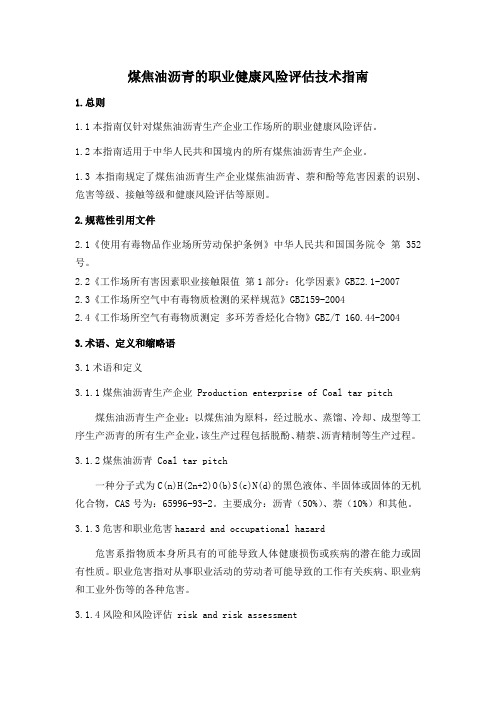
煤焦油沥青的职业健康风险评估技术指南1.总则1.1本指南仅针对煤焦油沥青生产企业工作场所的职业健康风险评估。
1.2本指南适用于中华人民共和国境内的所有煤焦油沥青生产企业。
1.3本指南规定了煤焦油沥青生产企业煤焦油沥青、萘和酚等危害因素的识别、危害等级、接触等级和健康风险评估等原则。
2.规范性引用文件2.1《使用有毒物品作业场所劳动保护条例》中华人民共和国国务院令第352号。
2.2《工作场所有害因素职业接触限值第1部分:化学因素》GBZ2.1-20072.3《工作场所空气中有毒物质检测的采样规范》GBZ159-20042.4《工作场所空气有毒物质测定多环芳香烃化合物》GBZ/T 160.44-20043.术语、定义和缩略语3.1术语和定义3.1.1煤焦油沥青生产企业 Production enterprise of Coal tar pitch煤焦油沥青生产企业:以煤焦油为原料,经过脱水、蒸馏、冷却、成型等工序生产沥青的所有生产企业,该生产过程包括脱酚、精萘、沥青精制等生产过程。
3.1.2煤焦油沥青 Coal tar pitch一种分子式为C(n)H(2n+2)O(b)S(c)N(d)的黑色液体、半固体或固体的无机化合物,CAS号为:65996-93-2。
主要成分:沥青(50%)、萘(10%)和其他。
3.1.3危害和职业危害hazard and occupational hazard危害系指物质本身所具有的可能导致人体健康损伤或疾病的潜在能力或固有性质。
职业危害指对从事职业活动的劳动者可能导致的工作有关疾病、职业病和工业外伤等的各种危害。
3.1.4风险和风险评估 risk and risk assessment风险也称为危险,指危害或不期望事件发生的可能性或概率,即物质或因素在其使用或接触情况下将导致不良作用及危害程度的可能性或概率。
风险评估系指在特定条件下接触某危害因素,考虑所关注的固有危害特性或危害的潜在能力,计算或估计风险程度(包括伴随的不确定度)、决定风险是否允许或可接受,并考虑现有措施的整个过程。
铝用炭素危废沥青煤焦油综合利用技术的研究与应用

铝用炭素危废沥青煤焦油综合利用技术的研究与应用马军玺,金 岭(黄河鑫业有限公司,青海 西宁 811601)摘 要:利用沥青溶化后析出的危废煤焦油具有燃烧洁净、热值高,但粘度高、雾化性能差等特点,对煤焦油的性质和燃烧条件进行分析,介绍了危废煤焦油综合利用技术的研究和应用。
关键词:煤焦油;研究;利用中图分类号:TG146.2+1 文献标识码:A 文章编号:1002-5065(2020)19-0119-4Research and application of comprehensive utilization technologyof coal tar from hazardous waste pitch of carbon for aluminumMA Jun-xi,JIN Ling(Huanghe Xinye Co., Ltd. Xining, Qinghai 811601)Abstract: Using the characteristics of coal tar, such as clean combustion, high calorific value, high viscosity and poor atomization performance, which is separated from the melted asphalt, this paper analyzes the properties and combustion conditions of coal tar, and introduces the research and application of comprehensive utilization technology of coal tar.Keywords: Coal tar; research; utilization1 前言随着构建环保型社会的深入落实,节能减排工作已成为中央企业各项工作的重中之重。
[精品]煤焦油沥青的msds
![[精品]煤焦油沥青的msds](https://img.taocdn.com/s3/m/651f78c4011ca300a6c390dc.png)
[精品]煤焦油沥青的msds煤焦油沥青的MSDS第一部分化学品及企业标识化学品中文名:煤焦油化学品英文名:Coal Tar企业名称:地址:邮编:电子邮件地址:传真号码:企业应急电话:技术说明书编码:第二部分:成分/组成信息纯品混合物?有害物成分浓度 CASNo沥青 50% 8052-42-4萘 10% 91-20-3第三部分:危险性概述危险性类别:第3.2类。
中闪点易燃液体。
侵入途径:吸入、经皮吸收。
健康危害:作用于皮肤,引起皮炎、痤疮、毛囊炎、光毒性皮炎、中毒性黑皮病、疣赘及癌肿。
可引起鼻中隔损伤。
环境危害:对环境有危害,对大气可造成污染。
燃爆危险:本品易燃,为致癌物。
第四部分:急救措施皮肤接触:脱去污染的衣着,用肥皂水和清水彻底冲洗皮肤。
眼睛接触:提起眼睑,用流动清水或生理盐水冲洗。
就医。
吸入:迅速脱离现场至空气新鲜处。
保持呼吸道通畅。
如呼吸困难,给输氧。
如呼吸停止,立即进行人工呼吸。
就医。
食入:尽快彻底洗胃,就医。
第五部分:消防措施危险特性:其蒸汽与空气可形成爆炸性混合物,遇明火、高热极燃烧爆炸,与氧化剂接触猛烈反应,若遇高热,容器内压增大,有开裂或爆炸的危险。
有害燃烧产物:一氧化碳、二氧化碳。
灭火方法:消防人员必须佩戴过滤式防毒面具(全面罩)或隔离式呼吸器,穿全身防火防毒服,在上风向灭火,尽可以将容器从火场移至空旷处,喷水保持火场容器冷却,直至灭火结束。
处在火场中的容器若已变色或从安全泄压装置中产生声音,必须马上撤离,灭火剂:雾状水、泡沫、干粉、二氧化碳、砂土。
第六部分:泄漏应急处理应急处理:迅速撤离泄露污染区人员至安全区,并进行隔离,严格限制出入。
切断火源,建议应急处理人员佩戴自给正压式呼吸器,穿防毒服。
尽可能切断泄漏源,防止流入下水道、排洪沟等限制性空间。
小量泄露:用砂土或其它不燃材料吸附或吸收。
大量泄露;构筑围堤或挖坑收容,用泡沫覆盖,降低蒸汽危害,用泵转移至槽车或专门收集容器内,回收或运至废物处理场所处理。
煤沥青生产工艺
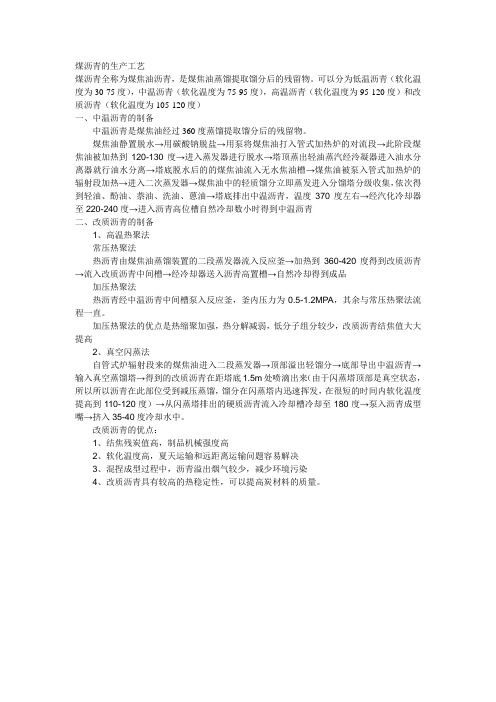
煤沥青的生产工艺煤沥青全称为煤焦油沥青,是煤焦油蒸馏提取馏分后的残留物。
可以分为低温沥青(软化温度为30-75度),中温沥青(软化温度为75-95度),高温沥青(软化温度为95-120度)和改质沥青(软化温度为105-120度)一、中温沥青的制备中温沥青是煤焦油经过360度蒸馏提取馏分后的残留物。
煤焦油静置脱水→用碳酸钠脱盐→用泵将煤焦油打入管式加热炉的对流段→此阶段煤焦油被加热到120-130度→进入蒸发器进行脱水→塔顶蒸出轻油蒸汽经泠凝器进入油水分离器就行油水分离→塔底脱水后的的煤焦油流入无水焦油槽→煤焦油被泵入管式加热炉的辐射段加热→进入二次蒸发器→煤焦油中的轻质馏分立即蒸发进入分馏塔分级收集,依次得到轻油、酚油、萘油、洗油、蒽油→塔底排出中温沥青,温度370度左右→经汽化冷却器至220-240度→进入沥青高位槽自然冷却数小时得到中温沥青二、改质沥青的制备1、高温热聚法常压热聚法热沥青由煤焦油蒸馏装置的二段蒸发器流入反应釜→加热到360-420度得到改质沥青→流入改质沥青中间槽→经冷却器送入沥青高置槽→自然冷却得到成品加压热聚法热沥青经中温沥青中间槽泵入反应釜,釜内压力为0.5-1.2MPA,其余与常压热聚法流程一直。
加压热聚法的优点是热缩聚加强,热分解减弱,低分子组分较少,改质沥青结焦值大大提高2、真空闪蒸法自管式炉辐射段来的煤焦油进入二段蒸发器→顶部溢出轻馏分→底部导出中温沥青→输入真空蒸馏塔→得到的改质沥青在距塔底1.5m处喷滴出来(由于闪蒸塔顶部是真空状态,所以所以沥青在此部位受到减压蒸馏,馏分在闪蒸塔内迅速挥发,在很短的时间内软化温度提高到110-120度)→从闪蒸塔排出的硬质沥青流入冷却槽冷却至180度→泵入沥青成型嘴→挤入35-40度冷却水中。
改质沥青的优点:1、结焦残炭值高,制品机械强度高2、软化温度高,夏天运输和远距离运输问题容易解决3、混捏成型过程中,沥青溢出烟气较少,减少环境污染4、改质沥青具有较高的热稳定性,可以提高炭材料的质量。
- 1、下载文档前请自行甄别文档内容的完整性,平台不提供额外的编辑、内容补充、找答案等附加服务。
- 2、"仅部分预览"的文档,不可在线预览部分如存在完整性等问题,可反馈申请退款(可完整预览的文档不适用该条件!)。
- 3、如文档侵犯您的权益,请联系客服反馈,我们会尽快为您处理(人工客服工作时间:9:00-18:30)。
物质安全资料表
序号:2 1 3第1 页/ 4页
一、物品与厂商资料
物品名称:挥发性煤焦油沥青(COAL TAR PITCH VOLATILES)
物品编号:-
制造商或供货商名称、地址及电话:-
紧急联络电话/ 传真电话:-
二、成分辨识资料
纯物质:
中英文名称:挥发性煤焦油沥青(COAL TAR PITCH VOLATILES)
同义名称:( P I T C H 、COA L TAR)
化学文摘社登记号码(CA S No . ):65996-93-2
危害物质成分(成分百分比):—
三、危害辨识数据
最重健康危害效应:刺激皮肤、眼睛、呼吸系统。
为致癌物质。
要危环境影响:—
害与物理性及化学性危害:粉尘可能会爆炸。
效应
特殊危害:—
主要症状:流鼻血、咳嗽、呼吸急促、头昏、头痛。
物品危害分类:-
四、急救措施
不同暴露途径之急救方法:
吸入:1 . 立即将患者移至新鲜空气处。
2 . 若呼吸停止,施予人工呼吸。
3 . 保持患者温暖及休息。
4 . 即刻送医。
皮肤接触:1 . 立即用肥皂或中性清洁剂及水清洗污染部位。
眼睛接触:1 . 立即撑开上下眼皮用大量的水冲洗。
2 . 冲洗后若仍有刺激感,需即刻就医。
食入:1 . 即刻就医。
最重要症状及危害效应:会导致头昏眼花、呼吸急促。
高浓度甚至会造成昏迷。
对急救人员之防护:应穿着 C 级防护装备在安全区实施急救。
对医师之提示:—
五、灭火措施
适用灭火剂:泡沫、化学干粉、二氧化碳。
灭火时可能遭遇之特殊危害:1.粉尘会爆炸, 蒸气云之最低着火温度是70 0 ℃。
特殊灭火程序:1 . 水雾可用来控制空气中之沥青粉粒,但在密闭槽中会产生气泡或喷出来。
2 . 安全情况下将容
物质安全资料表
序号:2 1 3第2 页/ 4页
器搬离火场。
3 .不要用高压水柱驱散泄漏物。
4 .停留在上风处,远离低洼。
消防人员之特殊防护装备:─
六、泄漏处理方法
个人应注意事项:1 .未穿戴防护装备及衣物之人员禁止进入泄漏区,直至完全清除为止。
环境注意事项:1 . 对泄漏区通风换气。
清理方法:1 . 利用最便利及安全之方法收集外泄物,以便回收或当废弃物处理。
七、安全处置与储存方法
处置:
1 . 无论操作、使用或贮存皆应在贴有警告标示且管制的通风良好区内。
2 . 接触或使用后都须彻底清洗。
储存:
1 . 限量储存。
八、暴露预防措施
九、物理及化学性质
物质安全资料表
序号:2 1 3第3 页/ 4 页
十、安定性及反应性
安定性:正常状况下安定
特殊状况下可能之危害反应:1 . 水雾可用来控制空气中之沥青粉粒,但在密闭槽中会产生气泡或喷出来。
2 . 粉
尘会爆炸, 蒸气云之最低着火温度是7 0 0 ℃ 。
3 . 强氧化剂:火灾爆炸危害。
应避免之状况:1 . 热源。
2 . 明火或形成粉尘。
应避免之物质:强氧化剂
危害分解物:—
十一、毒性资料
急毒性:1 . 刺激鼻、喉、呼吸道,引起鼻血、咳嗽及呼吸急促。
2 . 吸入蒸气会导致头昏眼花、头痛、食欲不振及情绪不稳定。
高浓度甚至会造成昏迷。
LD50( 测试动物、吸收途径) :-
LC50( 测试动物、吸收途径) :-
局部效应:-
致敏感性:—
慢毒性或长期毒性:1 . 为致癌物,可引起肺、皮肤、膀胱及肾脏等癌症。
2 . 皮肤色素改变及发疹。
3 . 眼睛产生棕色染斑。
4 . 下唇发炎。
特殊效应:I A R C 将之列为 G r o u p 1 :确定人类致癌。
ACGIH 将之列为 A 1 :确定人类致癌
十二、生态资料
可能之环境影响/ 环境流布:
-
十三、废弃处置方法
废弃处置方法:
1 . 依现行法规处理。
2 . 可密封于容器中再以安全之卫生掩埋处理。
十四、运送资料
国际运送规定:-
联合国编号:-
国内运输规定:1 . 道路交通安全规则第 84 条
2.船舶危险品装载规则
物质安全资料表
序号:2 1 3第4 页/ 4页
3.台湾铁路局危险品装卸运输实施细则
特殊运送方法及注意事项:
适用法规:
劳工安全卫生设施规则危险物及有害物通识规则
有机溶剂中毒预防规则劳工作业环境空气中有害物容许浓度标准
道路交通安全规则事业废弃物贮存清除处理方法及设施标准
参考文献1.CHEMINFO 数据库,C C I N F O 光盘,9 9 - 2
2.RTECS 数据库,T O M E S P L U S 光盘,V o l . 4 1 ,1 9 9 9
3 . OHS MSDS ON DITS,1999.
制表者单位名称:
地址/ 电话:
制表人职称:姓名(签章):
制表日期89.3.31
备注上述数据中符号” -” 代表目前查无相关数据,而符号”/” 代表此字段对该物质并不适用。
上述资料由工研院工安卫中心提供,工安卫中心对上述资料已力求正确,但错误恐仍难免,各项数
工业技术研究院
据与数据仅供参考,用户请依应用需求,自行负责判断其可用性,工研院不负任何责任。
工业安全卫生技术发展中心。
